| Revision as of 04:31, 4 May 2019 edit103.82.78.110 (talk) Fixed typoTags: canned edit summary Mobile edit Mobile app edit Android app edit← Previous edit | Revision as of 08:52, 4 May 2019 edit undoपाटलिपुत्र (talk | contribs)Autopatrolled, Extended confirmed users74,385 edits →History: Art of Prehistoric Egypt, some content adapted from Prehistoric EgyptNext edit → | ||
| Line 366: | Line 366: | ||
| </gallery> | </gallery> | ||
| ==History== | ==History of Egyptian art== | ||
| ===Art of Prehistoric Egypt=== | |||
| ] figurine, a Naqada jar, an ivory figurine, a ] vase, a ], a ].]] | |||
| The ] spans the period from the earliest human settlement to the beginning of the ] around 3100 BC, starting with the first ], ] for some Egyptologists, ] for others, with the name ] also possibly used for one of these kings. This Predynastic era is traditionally equivalent to the final part of the ] period beginning c. 6000 BC and ends in the ] period c. 3000 BC. | |||
| Continued expansion of the desert forced the early ancestors of the ] to settle around the ] more permanently and adopt a more sedentary lifestyle during the ]. The period from 9000 to 6000 BC has left very little in the way of archaeological evidence. Around 6000 BC, Neolithic settlements appear all over Egypt.<ref name="Redford 6">{{cite book|last1=Redford|first1=Donald B|title=Egypt, Canaan, and Israel in Ancient Times|location=Princeton|publisher=University Press|date=1992|page=6}}</ref> Studies based on ],<ref>{{cite journal | last1 = Brace | first1 = C. Loring | last2 = Seguchi | first2 = Noriko | last3 = Quintyn | first3 = Conrad B. | last4 = Fox | first4 = Sherry C. | last5 = Nelson | first5 = A. Russell | last6 = Manolis | first6 = Sotiris K. | last7 = Qifeng | first7 = Pan | year = 2006 | title = The questionable contribution of the Neolithic and the Bronze Age to European craniofacial form | url = | journal = ] | volume = 103 | issue = 1| pages = 242–247 | doi = 10.1073/pnas.0509801102 | pmid=16371462 | pmc=1325007|bibcode = 2006PNAS..103..242B }}</ref> ],<ref>{{cite journal | last1 = Chicki | first1 = L | last2 = Nichols | first2 = RA | last3 = Barbujani | first3 = G | last4 = Beaumont | first4 = MA | year = 2002 | title = Y genetic data support the Neolithic demic diffusion model | url = http://www.pnas.org/cgi/reprint/99/17/11008 | journal = Proc. Natl. Acad. Sci. USA | volume = 99 | issue = 17| pages = 11008–11013 | doi=10.1073/pnas.162158799|bibcode = 2002PNAS...9911008C | pmid=12167671 | pmc=123201}}</ref><ref>{{cite web|url=http://mbe.oxfordjournals.org/cgi/content/full/21/7/1361/T03 |title=Estimating the Impact of Prehistoric Admixture on the Genome of Europeans, Dupanloup et al., 2004 |publisher=Mbe.oxfordjournals.org |date= |accessdate=1 May 2012}}</ref><ref>{{cite journal|title=Origin, Diffusion, and Differentiation of Y-Chromosome Haplogroups E and J: Inferences on the Neolithization of Europe and Later Migratory Events in the Mediterranean Area, 2004 |date= May 2004|pmc=1181965 |pmid=15069642 |doi=10.1086/386295 |volume=74 |journal=Am. J. Hum. Genet. |pages=1023–34 | last1 = Semino | first1 = O | last2 = Magri | first2 = C | last3 = Benuzzi | first3 = G |display-authors=etal }}</ref><ref>{{cite journal|url=http://www.pubmedcentral.nih.gov/picrender.fcgi?artid=1715849&blobtype=pdf |title=Paleolithic and Neolithic lineages in the European mitochondrial gene pool|last1=Cavalli-Sforza|date=1997 |accessdate=1 May 2012|pmc=1715849|pmid=9246011|doi=10.1016/S0002-9297(07)64303-1|volume=61|journal=Am J Hum Genet|pages=247–54}}</ref><ref>{{cite journal|url=http://www.pnas.org/cgi/reprint/95/15/9053 |title=Clines of nuclear DNA markers suggest a largely Neolithic ancestry of the European gene|last1=Chikhi|journal=PNAS| volume=95|pages=9053–9058|date=21 July 1998 |accessdate=1 May 2012 |issue=15 |doi=10.1073/pnas.95.15.9053 |pmid=9671803 |pmc=21201|bibcode = 1998PNAS...95.9053C }}</ref> and ] data<ref name="Bar Yosef pages 159"/><ref>{{cite book|first1=M.|last1=Zvelebil|title=Hunters in Transition: Mesolithic Societies and the Transition to Farming|publisher=Cambridge University Press|location=Cambridge, UK|date=1986|pages=5–15, 167–188}}</ref><ref>{{cite book|first1=P.|last1=Bellwood|title=First Farmers: The Origins of Agricultural Societies|publisher=Blackwell|location=Malden, MA|year=2005}}</ref><ref>{{cite journal|first1=M.|last1=Dokládal|first2=J.|last2=Brožek|title=Physical Anthropology in Czechoslovakia: Recent Developments|journal=Current Anthropology|volume=2|issue=5|date=1961|pages=455–477|doi=10.1086/200228}}</ref><ref>{{cite journal|first1=M.|last1=Zvelebil|title=On the transition to farming in Europe, or what was spreading with the Neolithic: a reply to Ammerman (1989)|journal=Antiquity|year=1989|volume=63|issue=239|pages=379–383|doi=10.1017/S0003598X00076110}}</ref> have attributed these settlements to migrants from the ] in the ] returning during the ], bringing ] to the region. However, other regions in Africa independently developed agriculture at about the same time: the ], the ], and ].<ref>{{cite book |last=Diamond|first= Jared|authorlink=Jared Diamond| year=1999|title=]|location= New York|publisher= Norton Press|isbn= 0-393-31755-2}}</ref> | |||
| =====Merimde culture (5000-4200 BC===== | |||
| From about 5000 to 4200 BC the ], so far only known from a big settlement site at the edge of the Western Delta, flourished in Lower Egypt. The culture has strong connections to the Faiyum A culture as well as the Levant. People lived in small huts, produced a simple undecorated pottery and had stone tools. Cattle, sheep, goats and pigs were held. Wheat, sorghum and barley were planted. The Merimde people buried their dead within the settlement and produced clay figurines.<ref>{{cite book|first1=Josef|last1=Eiwanger|section=Merimde Beni-salame|title=Encyclopedia of the Archaeology of Ancient Egypt|editor1-first=Kathryn A.|editor1-last=Bard|location=London/New York|date=1999|pages=501–505}}</ref> The first Egyptian lifesize head made of clay comes from Merimde.<ref>{{cite web |url=http://www.auswaertiges-amt.de/diplo/de/Aussenpolitik/KulturDialog/BilderMitBU/DAI/100JahreDAI,curImg=196968,__page=1.html |title=picture of the Merimde head |language=de |publisher=Auswaertiges-amt.de |date= |accessdate=1 May 2012 |deadurl=yes |archiveurl=https://web.archive.org/web/20120302154547/http://www.auswaertiges-amt.de/diplo/de/Aussenpolitik/KulturDialog/BilderMitBU/DAI/100JahreDAI%2CcurImg%3D196968%2C__page%3D1.html |archivedate=2 March 2012 |df=dmy-all }}</ref> | |||
| ====Badarian culture (4400-4000 BC)==== | |||
| ]]] | |||
| The ], from about 4400 to 4000 BC,<ref name="Shaw 479">{{cite book |editor-last=Shaw |editor-first=Ian |title=The Oxford History of Ancient Egypt |year=2000 |publisher=Oxford University Press |isbn=0-19-815034-2 |page=479 }}</ref> is named for the ] site near Der Tasa. It followed the Tasian culture, but was so similar that many consider them one continuous period. The Badarian Culture continued to produce the kind of pottery called blacktop-ware (albeit much improved in quality) and was assigned Sequence Dating numbers 21–29.<ref name="Gardiner 389"/> The primary difference that prevents scholars from merging the two periods is that Badarian sites use copper in addition to stone and are thus ] settlements, while the ] Tasian sites are still considered ].<ref name="Gardiner 389"/> | |||
| ====Naqada culture (4000-3000 BC)==== | |||
| ] | |||
| The ] is an archaeological culture of ] ] (ca. 4400–3000 BC), named for the town of ], ]. It is divided in three sub-periods: Naqada I, II and III. | |||
| =====Naqada I===== | |||
| The Amratian (Naqada I) culture lasted from about 4000 to 3500 BC.<ref name="Shaw 479"/> Black-topped ware continues to appear, but white cross-line ware, a type of pottery which has been decorated with close parallel white lines being crossed by another set of close parallel white lines, is also found at this time. The Amratian period falls between S.D. 30 and 39 in Petrie's ] system.<ref name="Gardiner 390">Gardiner, Alan, ''Egypt of the Pharaohs'' (Oxford: University Press, 1964), p. 390.</ref> | |||
| =====Naqada II===== | |||
| ] | |||
| The ] (Naqada II), from about 3500 to 3200 BC,<ref name="Shaw 479"/> is named after the site of ]. It was the next stage in Egyptian cultural development, and it was during this time that the foundation of Dynastic Egypt was laid. Gerzean culture is largely an unbroken development out of Amratian Culture, starting in the delta and moving south through upper Egypt, but failing to dislodge Amratian culture in Nubia.<ref name="Redford 16">Redford, Donald B. ''Egypt, Canaan, and Israel in Ancient Times.'' (Princeton: University Press, 1992), p. 16.</ref> Gerzean pottery is assigned values from S.D. 40 through 62, and is distinctly different from Amratian white cross-lined wares or black-topped ware.<ref name="Gardiner 390"/> Gerzean pottery was painted mostly in dark red with pictures of animals, people, and ships, as well as geometric symbols that appear derived from animals.<ref name="Redford 16"/> Also, "wavy" handles, rare before this period (though occasionally found as early as S.D. 35) became more common and more elaborate until they were almost completely ornamental.<ref name="Gardiner 390"/> | |||
| {{multiple image | |||
| | align = left | |||
| | direction =horizontal | |||
| | header=Gebel el-Arak knife (3300-3200 BC) | |||
| | total_width=350 | |||
| | image1 = Gebel el-Arak Knife ivory handle (front).jpg | |||
| | caption1 = <center>Egyptian prehistoric ] ivory handle (back), ], ]. ].<ref>{{cite web |title=Site officiel du musée du Louvre |url=http://cartelfr.louvre.fr/cartelfr/visite?srv=car_not_frame&idNotice=668 |website=cartelfr.louvre.fr}}</ref></center> | |||
| | image2 = Gebel el-Arak Knife ivory handle (front top part detail).jpg | |||
| | caption2 = <center>]n king as ] on the ]. This work of art both shows the influence of Mesopotamia on ] at an early date, during a period of ], and the state of Mesopotamian royal iconography during the Uruk period.<ref>{{cite web |title=Site officiel du musée du Louvre |url=http://cartelfr.louvre.fr/cartelfr/visite?srv=car_not_frame&idNotice=668 |website=cartelfr.louvre.fr}}</ref><ref>{{cite book |last1=Cooper |first1=Jerrol S. |title=The Study of the Ancient Near East in the Twenty-first Century: The William Foxwell Albright Centennial Conference |date=1996 |publisher=Eisenbrauns |isbn=9780931464966 |url=https://books.google.com/books?id=3hc1Yp0VcjoC&pg=PA10|pages=10-14 |language=en}}</ref></center> | |||
| | footer= | |||
| }} | |||
| Although the Gerzean Culture is now clearly identified as being the continuation of the ] period, significant amounts of ]n influences worked their way into Egypt during the ], which are indicative of ]. | |||
| Distinctly foreign objects and art forms entered Egypt during this period, indicating contacts with several parts of Asia. Objects such as the ] handle, which has patently Mesopotamian relief carvings on it, have been found in Egypt,<ref>Shaw, Ian. & Nicholson, Paul, ''The Dictionary of Ancient Egypt,'' (London: British Museum Press, 1995), p. 109.</ref> and the silver which appears in this period can only have been obtained from ].<ref name="Redford 16"/> | |||
| ]]] | |||
| In addition, Egyptian objects are created which clearly mimic Mesopotamian forms, although not slavishly.<ref name="Redford 18">Redford, Donald B. ''Egypt, Canaan, and Israel in Ancient Times.'' (Princeton: University Press, 1992), p. 18.</ref> Cylinder seals appear in Egypt, as well as recessed paneling architecture, the Egyptian reliefs on cosmetic palettes are clearly made in the same style as the contemporary Mesopotamian ], and the ceremonial mace heads which turn up from the late Gerzean and early Semainean are crafted in the Mesopotamian "pear-shaped" style, instead of the Egyptian native style.<ref name="Redford 17"/> | |||
| The route of this trade is difficult to determine, but contact with ] does not predate the early dynastic, so it is usually assumed to have been by water.<ref name="Redford 22">Redford, Donald B. ''Egypt, Canaan, and Israel in Ancient Times.'' (Princeton: University Press, 1992), p. 22.</ref> During the time when the Dynastic Race Theory was still popular, it was theorized that Uruk sailors circumnavigated ], but a ] route, probably by middlemen through ], is more likely, as evidenced by the presence of ] objects in Egypt.<ref name="Redford 22"/> | |||
| The fact that so many Gerzean sites are at the mouths of ]s which lead to the Red Sea may indicate some amount of trade via the Red Sea (though Byblian trade potentially could have crossed the Sinai and then taken to the Red Sea).<ref name="Redford 20">Redford, Donald B. ''Egypt, Canaan, and Israel in Ancient Times.'' (Princeton: University Press, 1992), p. 20.</ref> Also, it is considered unlikely that something as complicated as recessed panel architecture could have worked its way into Egypt by proxy, and at least a small contingent of migrants is often suspected.<ref name="Redford 22"/> | |||
| Despite this evidence of foreign influence, Egyptologists generally agree that the Gerzean Culture is still predominantly indigenous to Egypt. | |||
| =====Protodynastic Period (Naqada III)===== | |||
| {{main|Naqada III}} | |||
| ], Naqada III.]] | |||
| The Naqada III period, from about 3200 to 3000 BC,<ref name="Shaw 479"/> is generally taken to be identical with the ] period, during which Egypt was unified. | |||
| Naqada III is notable for being the first era with ] (though this is disputed by some), the first regular use of ]s, the first irrigation, and the first appearance of royal cemeteries.<ref>{{cite web|url=http://www.faiyum.com/html/naqada_iii.html |title=Naqada III |publisher=Faiyum.com |date= |accessdate=1 May 2012}}</ref> The art of the Naqada III period becomes quite sophisticated, exmaplified by the ]s, originally used in ] ] to grind and apply ingredients for facial or body cosmetics. The decorative palettes of the late ] appear to have lost this function and became commemorative, ornamental, and possibly ceremonial. They were made almost exclusively out of ] with a few exceptions. The siltstone originated from quarries in the ]. Many of the palettes were found at ], a centre of power in ] ]. After the unification of the country, the palettes ceased to be included in tomb assemblages. | |||
| ]; circa 2450 BC; wood, copper and rock crystal; height: 1.1 m; from ]; ] (Cairo)]] | ]; circa 2450 BC; wood, copper and rock crystal; height: 1.1 m; from ]; ] (Cairo)]] | ||
Revision as of 08:52, 4 May 2019
| This article may require copy editing for grammar, style, cohesion, tone, or spelling. You can assist by editing it. (March 2019) (Learn how and when to remove this message) |
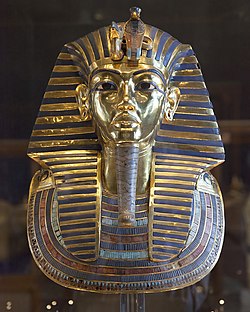


Ancient Egyptian art refers to paintings, sculptures, architecture and other arts produced by the civilization of ancient Egypt in the lower Nile Valley between the periods of about the 31st century BC to the 4th century AD. Ancient Egyptian art reached a high level in painting and sculpture and was both highly stylized and symbolic. It was famously conservative, and Egyptian styles changed remarkably little over the three thousand-year period. Much of the surviving art comes from tombs and monuments which have given greater insight on the Egyptians belief of the afterlife and has caused a greater focus on preserving knowledge of the past. Wall art was not produced to be seen, rather had a purpose in the afterlife.
| Ancient art history |
|---|
| Middle East |
| Asia |
| European prehistory |
| Classical art |
Ancient Egyptian art included paintings, sculptures in wood (now rarely surviving), stone and ceramics, drawings on papyrus, faience, jewelry, ivories, and other art media. It displays an extraordinarily vivid representation of the ancient Egyptian's socioeconomic status and belief systems.
The Ancient Egyptian language had no word for "art", rather, art served an essentially functional purpose that was intimately bound up with religion and ideology. To render a subject in art was to give it permanence. Hence, ancient Egyptian art portrayed an idealized, not realistic, view of the world. There was no tradition of individual artistic expression since art served a wider, cosmic purpose of maintaining created order.
Characteristics
Egyptian art is famous for its distinctive figure convention used for the main figures in both relief and painting, with parted legs (where not seated) and head shown as seen from the side, but the torso seen as from the front, and a standard set of proportions making up the figure, using 18 "fists" to go from the ground to the hair-line on the forehead. This appears as early as the Narmer Palette from Dynasty I, but this figure convention is not employed in the use of displaying minor figures shown engaged in some activity, such as the captives and corpses. Other conventions make statues of males darker than females ones. Very conventionalized portrait statues appear from as early as Dynasty II, before 2,780 BC, and with the exception of the art of the Amarna period of Ahkenaten, and some other periods such as Dynasty XII, the idealized features of rulers, like other Egyptian artistic conventions, changed little until after the Greek conquest. Egyptian art uses hierarchical proportions, where the size of figures indicates their relative importance. The gods or the divine pharaoh are usually larger than other figures while the figures of high officials or the tomb owner are usually smaller, and at the smallest scale are any servants, entertainers, animals, trees, and architectural details.

Symbolism
Symbolism pervaded Egyptian art and played an important role in establishing a sense of order. The pharaoh's regalia, for example, represented his power to maintain order. Animals were also highly symbolic figures in Egyptian art. Some colors were expressive. The ancient Egyptian language had 4 basic colour terms: kem (black), hedj (white/silver), wadj (green/blue) and desher (red/orange/yellow).
Blue, for example, symbolized fertility, birth, and the life-giving waters of the Nile. Blue and green were the colors of vegetation, and hence of rejuvenation. Osiris could be shown with green skin; in the 26th Dynasty, the faces of coffins were often colored green to assist in rebirth.
This color symbolism also explains the popularity of turquoise and faience in funerary equipment. The use of black for royal figures similarly expressed the fertile alluvial soil of the Nile from which Egypt was born, and carried connotations of fertility and regeneration. Hence statues of the king as Osiris often showed him with black skin. Black was also associated with the afterlife, and was the color of funerary deities such as Anubis.
Gold indicated divinity due to its unnatural appearance and association with precious materials. Furthermore, gold was regarded by the ancient Egyptians as "the flesh of the god." Silver, referred to as "white gold" by the Egyptians, was likewise called "the bones of the god."
Red, orange and yellow were ambivalent colors. They were, naturally, associated with the sun; red stones such as quartzite were favored for royal statues which stressed the solar aspects of kingship. Carnelian has similar symbolic associations in jewelry. Red ink was used to write important names of papyrus documents. However, red was also the color of the deserts, and hence associated with Seth.
Materials
Glass and faience
| This section needs additional citations for verification. Please help improve this article by adding citations to reliable sources in this section. Unsourced material may be challenged and removed. (February 2019) (Learn how and when to remove this message) |
Egyptian faience, made from silica, found in form of quartz in sand, lime, and natron, produced relatively cheap and very attractive small objects in a variety of colors, and was used for a variety of types of objects including jewelry. Ancient Egyptian glass goes back to very early Egyptian history but was at first very much a luxury material. In later periods it became common, and highly decorated small jars for perfume and other liquids are often found as grave goods.
Ancient Egyptians used steatite (some varieties were called soapstone) and carved small pieces of vases, amulets, images of deities, of animals and several other objects. Ancient Egyptian artists also discovered the art of covering pottery with enamel. Covering by enamel was also applied to some stone works. The color blue, first used in the very expensive imported stone lapis lazuli, was highly regarded by ancient Egypt, and the pigment Egyptian blue was widely used to color a variety of materials.
-
 Amphora; 1295–1070 BC; glass; height: 10.6 cm (43⁄16 in.); Metropolitan Museum of Art (New York City)
Amphora; 1295–1070 BC; glass; height: 10.6 cm (43⁄16 in.); Metropolitan Museum of Art (New York City)
-
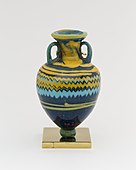 Small amphoriskos; 664–332 BC; glass; height: 7 cm (23⁄4 in.); Metropolitan Museum of Art
Small amphoriskos; 664–332 BC; glass; height: 7 cm (23⁄4 in.); Metropolitan Museum of Art
-
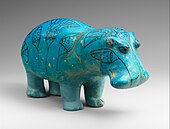 William the Faience Hippopotamus; 1961–1878 BC; faience; height: 11.2 cm (47⁄16 in.), width: 7.5 cm (215⁄16 in.); Metropolitan Museum of Art
William the Faience Hippopotamus; 1961–1878 BC; faience; height: 11.2 cm (47⁄16 in.), width: 7.5 cm (215⁄16 in.); Metropolitan Museum of Art
-
 Bowl; 200–150 BC; faience; height: 4.8 cm (17⁄8 in.), diameter: 16.9 cm (65⁄8 in.); Metropolitan Museum of Art
Bowl; 200–150 BC; faience; height: 4.8 cm (17⁄8 in.), diameter: 16.9 cm (65⁄8 in.); Metropolitan Museum of Art
Egyptian blue
Main article: Egyptian blueEgyptian blue is a material related to, but distinct from, faience and glass. Also called frit, Egyptian blue was made from quartz, alkali, lime and one or more coloring agents (especially copper compounds). These were heated together until they fused to become a crystalline mass, of uniform color throughout (unlike faience in which the core and the surface layer are of different colors). Egyptian blue could be worked by hand or pressed into molds, to make statuettes and other small objects. It could also be ground to produce pigment. It is first attested in the 4th Dynasty, but became particularly popular in the Ptolemaic Period and the Roman period, when it was known as caeruleum.
-
 Powder of Egyptian blue
Powder of Egyptian blue
-
 Amphora, a rare and fine example of so-called "Egyptian blue" ceramic ware; 1380–1300 BC; height: 12.6 cm (4.9 in.); Walters Art Museum (Baltimore, USA)
Amphora, a rare and fine example of so-called "Egyptian blue" ceramic ware; 1380–1300 BC; height: 12.6 cm (4.9 in.); Walters Art Museum (Baltimore, USA)
-
Etruscan pyxis; 750–700 BC; Altes Museum (Berlin, Germany)
Metals
While not a leading center of metallurgy, ancient Egypt nevertheless developed technologies for extracting and processing most of the metals found within its own borders and in neighbouring lands.
Copper
Copper was the first metal to be exploited in Egypt. Small beads have been found in Badarian graves; larger items were produced in the later Predynastic Period, by a combination of mould-casting, annealing and cold-hammering. The production of copper artifacts peaked in the Old Kingdom when huge numbers of copper chisels were manufactured to cut the stone blocks of pyramids. The copper statues of Pepi I and Merenre from Hierakonpolis are rare survivors of large-scale metalworking.
Gold
The golden treasure of Tutankhamun has come to symbolize the wealth of ancient Egypt, and illustrates the importance of gold in pharaonic culture. Indeed, the burial chamber in a royal tomb was called "the house of gold". According to the Egyptian religion, the flesh of the gods was made of gold. A shining metal that never tarnished, it was the ideal material for cult images of deities, for royal funerary equipment, and to add brilliance to the tops of obelisks. It was used extensively for jewelry, and was distributed to officials as a reward for loyal services ("the gold of honour").
Silver
Silver had to be imported from the levant, and its rarity initially gave it greater value than gold (which, like electrum, was readily available within the borders of Egypt and Nubia). Early examples of silver working include the bracelets of the Hetepheres. By the Middle Kingdom, silver is more widely attested and seems to have become less valuable than gold, perhaps because of increased trade with the Middle East. The treasure from El-Tod consisted of a hoard of silver objects, probably made in the Aegean, while silver jewelry made for female members of the 12th Dynasty royal family was found at Dahshur and Lahun. In the Egyptian religion, the bones of the gods were said to be made of silver.
Iron
Iron was the last metal to be exploited on a large scale by the Egyptians. Meteoritic iron was used for the manufacture of beads from the Badarian period. However, the advanced technology required to smelt iron was not introduced into Egypt until the Late Period. Before that, iron objects were imported and were consequently highly valued for their rarity. The Amarna letters refer to diplomatic gifts of iron being sent by Near Eastern rulers, especially the Hittites, to Amenhotep III and Akhenaten. Iron tools and weapons only became common in Egypt in the Roman Period.
-
 Headband with heads of gazelles and a stag between stars or flowers; 1648–1540 BC; gold; length of the headband: 49.5 cm (191⁄2 in.); Metropolitan Museum of Art (New York City)
Headband with heads of gazelles and a stag between stars or flowers; 1648–1540 BC; gold; length of the headband: 49.5 cm (191⁄2 in.); Metropolitan Museum of Art (New York City)
-
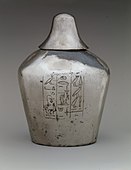 Libation vessel; 1479–1425 BC; silver; height: 19.5 cm (75⁄8 in.), diameter: 13 cm (51⁄8 in.); from Thebes; Metropolitan Museum of Art
Libation vessel; 1479–1425 BC; silver; height: 19.5 cm (75⁄8 in.), diameter: 13 cm (51⁄8 in.); from Thebes; Metropolitan Museum of Art
-
 Statuette of Amun; 945–715 BC; gold height: 17.5 cm (67⁄8 in.), width: 4.7 cm (17⁄8 in.); Metropolitan Museum of Art
Statuette of Amun; 945–715 BC; gold height: 17.5 cm (67⁄8 in.), width: 4.7 cm (17⁄8 in.); Metropolitan Museum of Art
-
 Cat statuette intended to contain a mummified cat; 332–30 BC; leaded bronze; height: 27.4 cm (1013⁄16 in.); Metropolitan Museum of Art
Cat statuette intended to contain a mummified cat; 332–30 BC; leaded bronze; height: 27.4 cm (1013⁄16 in.); Metropolitan Museum of Art
Wood
Because of its relatively poor survival in archaeological contexts, wood is not particularly well represented among artifacts from Ancient Egypt. Nevertheless, woodworking was evidently carried out to a high standard from an early period. Native trees included date palm and dom palm, the trunks of which could be used as joists in buildings, or split to produce planks. Tamarisk, acacia and sycamore fig were employed in furniture manufacture, while ash was used when greater flexibility was required (for example in the manufacture of bowls). However, all these native timbers were of relatively poor quality; finer varieties had to be imported, especially from the Levant.
-
 Figurine of a female servant carrying provisions; 1981–1975 BC; painted wood and gesso; height: 112 cm, width: 17 cm; Metropolitan Museum of Art (New York City)
Figurine of a female servant carrying provisions; 1981–1975 BC; painted wood and gesso; height: 112 cm, width: 17 cm; Metropolitan Museum of Art (New York City)
-
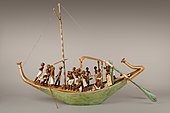 Model of a sailboat; 1981–1975 BC; painted wood, plaster, linen twine and linen fabric; length: 145 cm, with rudder; Metropolitan Museum of Art
Model of a sailboat; 1981–1975 BC; painted wood, plaster, linen twine and linen fabric; length: 145 cm, with rudder; Metropolitan Museum of Art
-
 Duck-shaped box; 16th–11th century BC; wood and ivory; Louvre
Duck-shaped box; 16th–11th century BC; wood and ivory; Louvre
-
 Figurine of Isis; Ptolemaic dynasty; painted wood and stucco; height: 40.5 cm; Roemer- und Pelizaeus-Museum Hildesheim (Hildesheim, Germany)
Figurine of Isis; Ptolemaic dynasty; painted wood and stucco; height: 40.5 cm; Roemer- und Pelizaeus-Museum Hildesheim (Hildesheim, Germany)
Lapis lazuli
See also: Lapis lazuliLapis lazuli is a dark blue semi-precious stone highly valued by the ancient Egyptians because of its symbolic association with the heavens. It was imported via long-distance trade routes from the mountains of north-eastern Afghanistan, and was considered superior to all other materials except gold and silver. Coloured glass or faience provided a cheap imitation. Lapis lazuli is first attested in the Predynastic Period. A temporary interruption in supply during the 2nd and 3rd Dynasties probably reflects political changes in the Near East. Thereafter, it was used extensively for jewelry, small figurines and amulets.
-
 Scarab finger ring; 1850–1750 BC; diameter: 2.5 cm (1 in.), length of the scarab: 1.8 cm (11⁄16 in.); Metropolitan Museum of Art (New York City)
Scarab finger ring; 1850–1750 BC; diameter: 2.5 cm (1 in.), length of the scarab: 1.8 cm (11⁄16 in.); Metropolitan Museum of Art (New York City)
-
 Fish-shaped amulet; 1550–1295 BC; length: 1.8 cm; Metropolitan Museum of Art
Fish-shaped amulet; 1550–1295 BC; length: 1.8 cm; Metropolitan Museum of Art
-
 Cult image of Ptah: 945–600 BC; height of the figure: 5.2 cm (21⁄16 in.), height of the dais: 0.4 cm (3⁄16 in.); Metropolitan Museum of Art
Cult image of Ptah: 945–600 BC; height of the figure: 5.2 cm (21⁄16 in.), height of the dais: 0.4 cm (3⁄16 in.); Metropolitan Museum of Art
-
 Falcom amulet; 664–332 BC; height: 2.2 cm (7⁄8 in.); Metropolitan Museum of Art
Falcom amulet; 664–332 BC; height: 2.2 cm (7⁄8 in.); Metropolitan Museum of Art
Other materials
- Jasper is an impure form of chalcedony with bands or patches of red, green or yellow. Red jasper, symbol of life and of positive aspects of the universe, was used above all to make amulets. It was imperative that certain amulets, such as the tit amulet, or tyet (also known as knot of Isis), were made of red jasper (at least ideally), as specified in Spell 156 of the Book of the Dead. The more rarely used green jasper was especially indicated for making scarabs, particularly heart scarabs.
- Serpentine is the generic term for the hydrated silicates of magnesium. It came mostly from the eastern desert, and occurs in many shades of colour, from a pale green to a dark verging on black. Used from the earliest times, it was sought specially for making heart scarabs.
- Steatite (also known as soapstone) is a mineral of the chlorite family; it has the great advantage of being very easily worked. Steatite amulets are found in contexts from the Predynastic Period on, although in subsequent periods it was usually covered in a fine layer of faience and was used in the manufacture of numerous scarabs.
- Turquoise is an opaque stone, sky blue to blue-green. Turquoise id a natural basic aluminium phosphate coloured blue by traces of copper. Closely linked to the goddess Hathor, it was extracted mainly from mines in Sinai (at Serabit el-Khadim). The Egyptians were particularly fond of the greenish shades, symbolic of dynamism and vital renewal. In the Late Period, turquoise (like lapis lazuli) was synonymous with joy and delight.
-
 Fish pendant; 1878-1749 BC; turquoise and gold; height: 1 cm, length: 2.1 cm; Metropolitan Museum of Art (New York City)
Fish pendant; 1878-1749 BC; turquoise and gold; height: 1 cm, length: 2.1 cm; Metropolitan Museum of Art (New York City)
-
 Heart scarab of Hatnefer; 1492-1473 BC; serpentine (the scarab) and gold; the scarab: width 5.3 cm, height: 2.8 cm; the chain: length: 77.5 cm; Metropolitan Museum of Art
Heart scarab of Hatnefer; 1492-1473 BC; serpentine (the scarab) and gold; the scarab: width 5.3 cm, height: 2.8 cm; the chain: length: 77.5 cm; Metropolitan Museum of Art
-
 Head from a spoon in the form of a swimming girl; 1390-1353 BC; travertine (the head) and steatite (the hair); height: 2.8 cm, width: 2.7 cm; Metropolitan Museum of Art
Head from a spoon in the form of a swimming girl; 1390-1353 BC; travertine (the head) and steatite (the hair); height: 2.8 cm, width: 2.7 cm; Metropolitan Museum of Art
-
 Amulet; 1295-1070 BC; red jasper; height: 2.3 cm, width: 1.2 cm; Metropolitan Museum of Art
Amulet; 1295-1070 BC; red jasper; height: 2.3 cm, width: 1.2 cm; Metropolitan Museum of Art
Painting
| This section needs additional citations for verification. Please help improve this article by adding citations to reliable sources in this section. Unsourced material may be challenged and removed. (February 2019) (Learn how and when to remove this message) |

Not all Egyptian reliefs were painted, and less prestigious works in tombs, temples and palaces were merely painted on a flat surface. Stone surfaces were prepared by whitewash, or if rough, a layer of coarse mud plaster, with a smoother gesso layer above; some finer limestones could take paint directly. Pigments were mostly mineral, chosen to withstand strong sunlight without fading. The binding medium used in painting remains unclear: egg tempera and various gums and resins have been suggested. It is clear that true fresco, painted into a thin layer of wet plaster, was not used. Instead the paint was applied to dried plaster, in what is called "fresco a secco" in Italian. After painting, a varnish or resin was usually applied as a protective coating, and many paintings with some exposure to the elements have survived remarkably well, although those on fully exposed walls rarely have. Small objects including wooden statuettes were often painted using similar techniques.
Many ancient Egyptian paintings have survived in tombs, and sometimes temples, due to Egypt's extremely dry climate. The paintings were often made with the intent of making a pleasant afterlife for the deceased. The themes included journey through the afterworld or protective deities introducing the deceased to the gods of the underworld (such as Osiris). Some tomb paintings show activities that the deceased were involved in when they were alive and wished to carry on doing for eternity.
In the New Kingdom and later, the Book of the Dead was buried with the entombed person. It was considered important for an introduction to the afterlife.
Egyptian paintings are painted in such a way to show a profile view and a side view of the animal or person at the same time. For example, the painting to the right shows the head from a profile view and the body from a frontal view. Their main colors were red, blue, green, gold, black and yellow.
Paintings showing scenes of hunting and fishing can have lively close-up landscape backgrounds of reeds and water, but in general Egyptian painting did not develop a sense of depth, and neither landscapes nor a sense of visual perspective are found, the figures rather varying in size with their importance rather than their location.
-
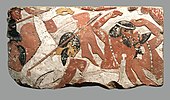 Block from a relief depicting a battle; 1427–1400 BC; painted sandstone; height: 61.5 cm (243⁄16 in.); Metropolitan Museum of Art (USA)
Block from a relief depicting a battle; 1427–1400 BC; painted sandstone; height: 61.5 cm (243⁄16 in.); Metropolitan Museum of Art (USA)
-
 Fresco which depicts Nebamun hunting birds; 1350 BC; paint on plaster; 98 x 83 cm (3 ft. 21⁄2 in. x 2 ft. 83⁄4 in.); British Museum (London)
Fresco which depicts Nebamun hunting birds; 1350 BC; paint on plaster; 98 x 83 cm (3 ft. 21⁄2 in. x 2 ft. 83⁄4 in.); British Museum (London)
-
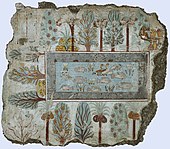 Fresco which depicts the pool in Nebamun's estate garden; circa 1350 BC; painted plaster; height: 64 cm (maxim); British Museum
Fresco which depicts the pool in Nebamun's estate garden; circa 1350 BC; painted plaster; height: 64 cm (maxim); British Museum
-
 Wall painting from Tutankhamun's tomb depicting Ay performing the Opening of the Mouth ceremony
Wall painting from Tutankhamun's tomb depicting Ay performing the Opening of the Mouth ceremony
-
 Scene from the tomb of Tutankhamun in which appears Osiris
Scene from the tomb of Tutankhamun in which appears Osiris
-
 Picture of the wall painting from the tomb of Sennedjem in which Anubis attends the mummy of the deceased
Picture of the wall painting from the tomb of Sennedjem in which Anubis attends the mummy of the deceased
-
 Book of the Dead of Hunefer; circa 1275 BC; ink and pigments on papyrus; 45 x 90.5 cm; British Museum (London)
Book of the Dead of Hunefer; circa 1275 BC; ink and pigments on papyrus; 45 x 90.5 cm; British Museum (London)
-
 Painted panel of Tatiaset; 825–712 BC; painted wood with gesso; height: 23.4 cm (93⁄16 in.); Metropolitan Museum of Art
Painted panel of Tatiaset; 825–712 BC; painted wood with gesso; height: 23.4 cm (93⁄16 in.); Metropolitan Museum of Art
Sculpture

The monumental sculpture of ancient Egypt's temples and tombs is world-famous, but refined and delicate small works exist in much greater numbers. The Egyptians used the technique of sunk relief, which is best viewed in sunlight for the outlines and forms to be emphasized by shadows. The distinctive pose of standing statues facing forward with one foot in front of the other was helpful for the balance and strength of the piece. The use of this singular pose was used early on in the history of Egyptian art and well into the Ptolemaic period, although seated statues were particularly common as well.
Egyptian pharaohs were always regarded as gods, but other deities are much less common in large statues, except when they represent the pharaoh as another deity; however the other deities are frequently shown in paintings and reliefs. The famous row of four colossal statues outside the main temple at Abu Simbel each show Rameses II, a typical scheme, though here exceptionally large. Most larger sculptures survived from Egyptian temples or tombs; massive statues were built to represent gods and pharaohs and their queens, usually for open areas in or outside temples. The very early colossal Great Sphinx of Giza was never repeated, but avenues lined with very large statues including sphinxes and other animals formed part of many temple complexes. The most sacred cult image of a god in a temple, usually held in the naos, was in the form of a relatively small boat or barque holding an image of the god, and apparently usually in precious metal – none have survived.
By Dynasty IV (2680–2565 BC) at the latest the idea of the Ka statue was firmly established. These were put in tombs as a resting place for the ka portion of the soul, and so there is a good number of less conventionalized statues of well-off administrators and their wives, many in wood as Egypt is one of the few places in the world where the climate allows wood to survive over millennia, and many block statues. The so-called reserve heads, plain hairless heads, are especially naturalistic, though the extent to which there was real portraiture in ancient Egypt is still debated.

Early tombs also contained small models of the slaves, animals, buildings and objects such as boats necessary for the deceased to continue his lifestyle in the afterlife, and later Ushabti figures. However the great majority of wooden sculpture have been lost to decay, or probably used as fuel. Small figures of deities, or their animal personifications, are very common, and found in popular materials such as pottery. There were also large numbers of small carved objects, from figures of the gods to toys and carved utensils. Alabaster was often used for expensive versions of these; painted wood was the most common material, and normal for the small models of animals, slaves and possessions placed in tombs to provide for the afterlife.
Very strict conventions were followed while crafting statues, and specific rules governed the appearance of every Egyptian god. For example, the sky god (Horus) was to be represented with a falcon's head, the god of funeral rites (Anubis) was to be always shown with a jackal's head. Artistic works were ranked according to their compliance with these conventions, and the conventions were followed so strictly that, over three thousand years, the appearance of statues changed very little. These conventions were intended to convey the timeless and non-ageing quality of the figure's ka.
A common relief in ancient Egyptian sculpture was the difference between the representation of men and women. Women were often represented in an idealistic form, young and pretty, and rarely shown in an older maturity. While men were shown in either one of two way; either in an idealistic manner or in more realistic depiction. Sculptures of men often showed men that aged, since the regeneration of ageing was a positive thing for them whereas women are shown as perpetually young.
-
 The The Seated Scribe; 2613–2494 BC; painted limestone and inlaid quartz; height: 53.7 cm (1 ft. 91⁄4 in.); Louvre
The The Seated Scribe; 2613–2494 BC; painted limestone and inlaid quartz; height: 53.7 cm (1 ft. 91⁄4 in.); Louvre
-
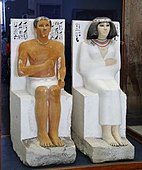 Statues of Rahotep and Nofret; 2649–2609 BC; painted limestone; height of Rahotep: 121 cm (37⁄8 ft.), height of Nofret: 122 cm (35⁄8 ft.); Egyptian Museum (Cairo)
Statues of Rahotep and Nofret; 2649–2609 BC; painted limestone; height of Rahotep: 121 cm (37⁄8 ft.), height of Nofret: 122 cm (35⁄8 ft.); Egyptian Museum (Cairo)
-
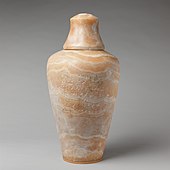 Water vessel; 1887-1813 BC; alabaster; height: 56 cm (22 in.), diameter: 26.7 cm (101⁄2 in.); from Lahun (Egypt); Metropolitan Museum of Art (New York City)
Water vessel; 1887-1813 BC; alabaster; height: 56 cm (22 in.), diameter: 26.7 cm (101⁄2 in.); from Lahun (Egypt); Metropolitan Museum of Art (New York City)
-
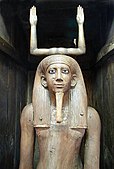 The Ka statue of Awibre Hor, which provided a physical place for the ka to manifest; circa 1700 BC; wood, rock crystal, quartz, plaster, traces of gold; height: 1.7 m (55⁄8 ft.); from Dahshur; Egyptian Museum (Cairo)
The Ka statue of Awibre Hor, which provided a physical place for the ka to manifest; circa 1700 BC; wood, rock crystal, quartz, plaster, traces of gold; height: 1.7 m (55⁄8 ft.); from Dahshur; Egyptian Museum (Cairo)
-
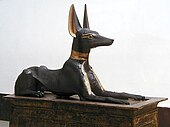 The Anubis Shrine; 1336–1327 BC; painted wood & gold; height: 1.1 m (35⁄8 ft.), length: 2.7 m (87⁄8 ft.), width: 52 cm (201⁄2 in.); from the Valley of the Kings; Egyptian Museum (Cairo)
The Anubis Shrine; 1336–1327 BC; painted wood & gold; height: 1.1 m (35⁄8 ft.), length: 2.7 m (87⁄8 ft.), width: 52 cm (201⁄2 in.); from the Valley of the Kings; Egyptian Museum (Cairo)
-
 Osiris on a lapis lazuli pillar in the middle, flanked by Horus on the left, and Isis on the right; 875–850 BC; gold & lapis lazuli; height: 9 cm (31⁄2 in.); Louvre
Osiris on a lapis lazuli pillar in the middle, flanked by Horus on the left, and Isis on the right; 875–850 BC; gold & lapis lazuli; height: 9 cm (31⁄2 in.); Louvre
-
 Statuette of Anubis; 332-30 BC; plastered and painted wood; height: 42.3 cm (165⁄8 in.); Metropolitan Museum of Art
Statuette of Anubis; 332-30 BC; plastered and painted wood; height: 42.3 cm (165⁄8 in.); Metropolitan Museum of Art
-
 Statue of Cleopatra V; 51–30 BC; black basalt; height: 1 m (31⁄2 ft.); Hermitage Museum (Saint Petersburg, Russia)
Statue of Cleopatra V; 51–30 BC; black basalt; height: 1 m (31⁄2 ft.); Hermitage Museum (Saint Petersburg, Russia)
Stelae
See also: Stele
A stelae is an upright tablet of stone or wood, often with a curved top, painted and carved with text and pictures. Numerous examples were produced throughout Egyptian history for a variety of purposes, including funerary, votive and commemorative. Funerary stelae, attested from the early 1st Dynasty, typically bore the name and titles of the deceased. This basic form, which served to identify the tomb owner, evolved into a key component of the funerary equipment with a magical function. Hence, from the 2nd Dynasty onwards, the owner was usually shown seated before an offering table piled with food and drink; in the Middle Kingdom, the offering formula was generally inscribed along the top of the stela. Both were designed to ensure a perpetual supply of offerings in the afterlife. Votive stelae, inscribed with prayers to deities, were dedicated by worshippers seeking a favourable outcome to a particular situation. In the Middle Kingdom, many hundreds were set up by pilgrims on the "terrace of the great god" at Abydos, so that they might participate in the annual procession of Osiris. One particular variety of votive stela common in the New Kingdom was the ear stela, inscribed with images of human ears to encourage the deity to listen to the prayer or request.
Commemorative stelae were produced to proclaim notable achievements (for example, the stela of Horwerra, recording a mining expedition to Serabit el-Khadim, and the Restoration Stela of Tutankhamun, celebrating the restoration of the traditional cults at the end of the Amarna period); to celebrate military victories (for instance, the Israel stela of Meren-Ptah); and to establish frontiers (for example the Semna stela of Senusret III and the boundary stelae around Amarna).
-
 Stele of Princess Nefertiabet eating; 2589–2566 BC; limestone & paint; height: 37.7 cm (147⁄8 in.), length: 52.5 cm (205⁄8 in.), depth: 8.3 cm (31⁄4 in.); from Giza; Louvre
Stele of Princess Nefertiabet eating; 2589–2566 BC; limestone & paint; height: 37.7 cm (147⁄8 in.), length: 52.5 cm (205⁄8 in.), depth: 8.3 cm (31⁄4 in.); from Giza; Louvre
-
 Stela of the lector priest of Amun Siamun and his mother the singer Amenhotep; circa 1420 BC; painted limestone; height: 32.5 cm (1213⁄16 in.); Metropolitan Museum of Art (New York City)
Stela of the lector priest of Amun Siamun and his mother the singer Amenhotep; circa 1420 BC; painted limestone; height: 32.5 cm (1213⁄16 in.); Metropolitan Museum of Art (New York City)
-
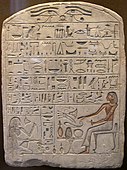 Stela of Pepi, chief of the potters; 8th century BC; limestone; Hermitage (Sankt Petersburg, Russia)
Stela of Pepi, chief of the potters; 8th century BC; limestone; Hermitage (Sankt Petersburg, Russia)
-
 Funerary stela of Thutirtis; 350–300 BC; painted limestone; height: 28.3 cm (111⁄8 in.); Metropolitan Museum of Art
Funerary stela of Thutirtis; 350–300 BC; painted limestone; height: 28.3 cm (111⁄8 in.); Metropolitan Museum of Art
Pyramidions
Main article: PyramidionA pyramidion is a capstone at the top of a pyramid. Called benbenet in ancient Egyptian language, it associated the pyramid as a whole with the sacred benben stone. Pyramidions may have been covered in gold leaf to reflect the rays of the sun; in the Middle Kingdom, they were often inscribed with royal titles and religious symbols.
-
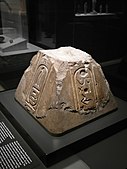 Fragment of a pyramidion; circa 1600 BC; from Thebes; British Museum (London)
Fragment of a pyramidion; circa 1600 BC; from Thebes; British Museum (London)
-
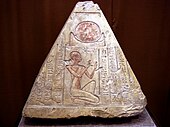 Pyramidion found in the tomb of the priest Rer form Abydos (Egypt); 7th century BC; limestone; Hermitage Museum (Saint Petersburg, Russia)
Pyramidion found in the tomb of the priest Rer form Abydos (Egypt); 7th century BC; limestone; Hermitage Museum (Saint Petersburg, Russia)
-
 Pyramidion of Iufaa; 664–525 BC; painted limestone; height: 36 cm (143⁄16 in.); Metropolitan Museum of Art (New York City)
Pyramidion of Iufaa; 664–525 BC; painted limestone; height: 36 cm (143⁄16 in.); Metropolitan Museum of Art (New York City)
Pottery
| This section needs additional citations for verification. Please help improve this article by adding citations to reliable sources in this section. Unsourced material may be challenged and removed. (February 2019) (Learn how and when to remove this message) |
Different types of pottery items were deposited in tombs of the dead. Some such pottery items represented interior parts of the body, like the lungs, the liver and smaller intestines, which were removed before embalming. A large number of smaller objects in enamel pottery were also deposited with the dead. It was customary to craft on the walls of the tombs cones of pottery, about six to ten inches tall, on which were engraved or impressed legends relating to the dead occupants of the tombs. These cones usually contained the names of the deceased, their titles, offices which they held, and some expressions appropriate to funeral purposes.
-
 Decorated jar depicting boats, by Naqada culture; 3850–2960 BC; painted pottery; Metropolitan Museum of Art (New York City)
Decorated jar depicting boats, by Naqada culture; 3850–2960 BC; painted pottery; Metropolitan Museum of Art (New York City)
-
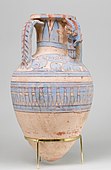 Blue-painted ibex amphora from Malqata; 1390–1353 BC; painted pottery; height: 39.5 cm (159⁄16 in.); Metropolitan Museum of Art
Blue-painted ibex amphora from Malqata; 1390–1353 BC; painted pottery; height: 39.5 cm (159⁄16 in.); Metropolitan Museum of Art
-
 Blue-painted jar from Malqata; 1390–1353 BC; painted pottery; height: 69.1 cm (273⁄16 in.); Metropolitan Museum of Art
Blue-painted jar from Malqata; 1390–1353 BC; painted pottery; height: 69.1 cm (273⁄16 in.); Metropolitan Museum of Art
-
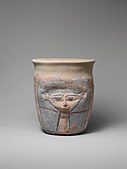 Hathor-shaped jar; 1390–1353 BC; painted pottery; height: 24.5 cm (95⁄8 in.); Metropolitan Museum of Art
Hathor-shaped jar; 1390–1353 BC; painted pottery; height: 24.5 cm (95⁄8 in.); Metropolitan Museum of Art
Architecture
Main articles: Ancient Egyptian architecture and Egyptian templeAncient Egyptian architects used sun-dried and kiln-baked bricks, fine sandstone, limestone and granite. Architects carefully planned all their work. The stones had to fit precisely together, since there was no mud or mortar. When creating the pyramids, ramps were used to allow workmen to move up as the height of the construction grew. When the top of the structure was completed, the artists decorated from the top down, removing ramp sand as they went down. Exterior walls of structures like the pyramids contained only a few small openings. Hieroglyphic and pictorial carvings in brilliant colors were abundantly used to decorate Egyptian structures, including many motifs, like the scarab, sacred beetle, the solar disk, and the vulture. They described the changes the Pharaoh would go through to become a god.
-
 The three main pyramids at Giza, together with subsidiary pyramids and the remains of other structures at the Giza pyramid complex
The three main pyramids at Giza, together with subsidiary pyramids and the remains of other structures at the Giza pyramid complex
-
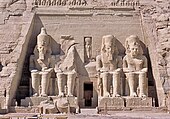 The Great Temple of Ramesses II, one of the Abu Simbel temples
The Great Temple of Ramesses II, one of the Abu Simbel temples
-
The well preserved Temple of Horus at Edfu is an example of Egyptian architecture and architectural sculpture
-
 Illustration of various types of capitals, drawn by the egyptologist Karl Richard Lepsius
Illustration of various types of capitals, drawn by the egyptologist Karl Richard Lepsius
Jewelry
| This section does not cite any sources. Please help improve this section by adding citations to reliable sources. Unsourced material may be challenged and removed. (February 2019) (Learn how and when to remove this message) |

The ancient Egyptians exhibited a love of ornament and personal decoration from earliest Predynastic times. Badarian burials often contained strings of beads made from glazed steatite, shell and ivory. Jewelry in gold, silver, copper and faience is also attested in the early Predynastic period; more varied materials were introduced in the centuries preceding the 1st Dynasty. By the Old Kingdom, the combination of carnelian, turquoise and lapis lazuli had been established for royal jewelry, and this was to become standard in the Middle Kingdom. Less sophisticated pieces might use bone, mother-of-pearl or cowrie shells. The particular choice of materials depended upon pactical, aesthetical and symbolic considerations. Some types of jewelry remained perennially popular, while other went in and out of fashion. In the first category were bead necklances, bracelets, armlets and girdles. Bead aprons are first attested in the 1st Dynasty, while broad collars became a standard type from the early Old Kingdom. In the Middle Kingdom they had fallen from favour, to be replaced by finger-rings and ear ornaments (rings and plugs). New Kingdom jewelry is generally more elaborate and garish than that of earlier periods, and was influenced by styles from the Ancient Greece and the Levant. Many fine examples were found in the tomb of Tutankhamun. Jewelry, both royal and private, was replete with religious symbolism. It was also used to display the wealth and rank of the wearer. Royal jewels were always the most elaborate, as exemplified by the pieces found at Dahshur and Lahun, made for princesses of the 18th Dynasty, favoured courtires were rewarded with the "gold of honour" as a sign of royal favour.
The techniques of jewelry-making can be reconstructed from surviving artefacts and from tomb decoration. A jewelers' workshop is shown in the tomb of Mereruka; several New Kingdom tombs at Thebes contain similar scenes.
-
 Pectoral (chest jewellery) of Tutankhamun; 1336–1327 BC (Reign of Tutankhamun); gold, silver and meteoric glass; height: 14.9 cm (53⁄4 in.); Egyptian Museum (Cairo)
Pectoral (chest jewellery) of Tutankhamun; 1336–1327 BC (Reign of Tutankhamun); gold, silver and meteoric glass; height: 14.9 cm (53⁄4 in.); Egyptian Museum (Cairo)
-
 Signet ring; 664–525 BC; gold; diameter: 3 cm (11⁄8 in.); length of the bezel: 3.4 cm (13⁄8 in.); British Museum (London)
Signet ring; 664–525 BC; gold; diameter: 3 cm (11⁄8 in.); length of the bezel: 3.4 cm (13⁄8 in.); British Museum (London)
-
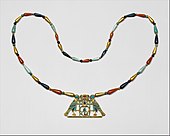 Pectoral and necklace of Princess Sithathoriunet; 1887–1813 BC; gold, carnelian, lapis lazuli, turquoise, garnet & feldspar; height of the pectoral: 4.5 cm (13⁄4 in.); Metropolitan Museum of Art (New York City)
Pectoral and necklace of Princess Sithathoriunet; 1887–1813 BC; gold, carnelian, lapis lazuli, turquoise, garnet & feldspar; height of the pectoral: 4.5 cm (13⁄4 in.); Metropolitan Museum of Art (New York City)
-
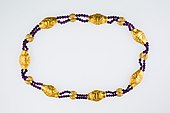 Leopard-head girdle of Sithathoriunet; 1887–1813 BC; gold, amethyst, diorite pellets (inside); Metropolitan Museum of Art
Leopard-head girdle of Sithathoriunet; 1887–1813 BC; gold, amethyst, diorite pellets (inside); Metropolitan Museum of Art
Amulets
Main article: List of ancient Egyptian statuary with amulet necklaces| This section does not cite any sources. Please help improve this section by adding citations to reliable sources. Unsourced material may be challenged and removed. (February 2019) (Learn how and when to remove this message) |
An amulet is small charm worn to afford its owner magical protection, or to convey certain qualities (for example, a lion amulet might convey strength, or a set-square amulet rectitude). Attested from the Badarian period onwards, amulets were produced both for the living and the dead. Particular amulets were placed at specific places in the mummy wrappings. The heart scarab was a scpecialized form of amulet to protect the heart of the deceased in the afterlife. Amulets were made from a wide variety of materials, including faience, glass, and precious stones - with colour often playing an important symbolic role - and in a wide variety of forms. They might depict sacred objects (such as the Djed pillar, Tyet girdle or Wedjad eye); animals (bull's head amulets were particularly common in the late Predynastic period); or hieroglyphs (for example, Ankh or Sa). From the New Kingdom onwards, deities – especially household deities such as Bes and Taweret – were popular subjects for amulets.
-
 Amulet that depicts Thoth-Baboon holding an Eye of Horus; 664–332 BC; Egyptian faience with light green glaze; height: 3.9 cm (1.5 in.); Walters Art Museum (Baltimore, USA)
Amulet that depicts Thoth-Baboon holding an Eye of Horus; 664–332 BC; Egyptian faience with light green glaze; height: 3.9 cm (1.5 in.); Walters Art Museum (Baltimore, USA)
-
 Amulet which depicts a triad of Isis, Horus and Nephthys; 664–332 BC; faience; height: 4.5 cm (13⁄4 in.); Metropolitan Museum of Art (New York City)
Amulet which depicts a triad of Isis, Horus and Nephthys; 664–332 BC; faience; height: 4.5 cm (13⁄4 in.); Metropolitan Museum of Art (New York City)
-
 Amulet depicting Taweret; 664–332 BC; faience; height: 9.7 cm (313⁄16 in.); Metropolitan Museum of Art
Amulet depicting Taweret; 664–332 BC; faience; height: 9.7 cm (313⁄16 in.); Metropolitan Museum of Art
-
 Djed pillar-shaped amulet; 664–30 BC; faience; height: 4.5cm (13⁄4 in); Metropolitan Museum of Art
Djed pillar-shaped amulet; 664–30 BC; faience; height: 4.5cm (13⁄4 in); Metropolitan Museum of Art
Scarab-shaped amulets
Main article: Scarab (artifact)The protective amulet for the heart was in the form of the scarab beetle, the manifestation of the creator and solar deity Khepri. It was a symbol of new life and resurrection. The scarab beetle was seen to push a ball of mud along the ground, and from this came the idea of the beetle rolling the sun across the sky. Subsequently, the young beetles were observed to hatch from their eggs inside the ball of mud, hence the idea of creation: life springs forth from primordial mud.
The heart scarab was a large scarab amulet which was wrapped in the mummy bandaging over the deceased's heart. It was made out of a range of green and dark-coloured materials, including faience, glass, glazed steatite, shist, feldspar, hematite and obsidian; black being also associated with the afterlife, meanwhile blue and green were associated with the birth and the life-giving waters of the Nile.
-
 Heart scarab of the singer of Amun Iakai; 1550-1186 BC; glass; length: 4.8 cm, width: 3.5 cm; Metropolitan Museum of Art (New York City)
Heart scarab of the singer of Amun Iakai; 1550-1186 BC; glass; length: 4.8 cm, width: 3.5 cm; Metropolitan Museum of Art (New York City)
-
 The back of a heart scarab of the singer of Amun Iakai; 1550-1186 BC; glass; length: 4.8 cm, width: 3.5 cm; Metropolitan Museum of Art
The back of a heart scarab of the singer of Amun Iakai; 1550-1186 BC; glass; length: 4.8 cm, width: 3.5 cm; Metropolitan Museum of Art
-
 Commemorative scarab of Amenhotep III, recording a lion hunt; 1390-1352 BC; blue glazed steatite; length: 8 cm; Metropolitan Museum of Art
Commemorative scarab of Amenhotep III, recording a lion hunt; 1390-1352 BC; blue glazed steatite; length: 8 cm; Metropolitan Museum of Art
-
 The back of a commemorative scarab of Amenhotep III, recording a lion hunt; 1390-1352 BC; blue glazed steatite; length: 8 cm; Metropolitan Museum of Art
The back of a commemorative scarab of Amenhotep III, recording a lion hunt; 1390-1352 BC; blue glazed steatite; length: 8 cm; Metropolitan Museum of Art
Calligraphy
| This section does not cite any sources. Please help improve this section by adding citations to reliable sources. Unsourced material may be challenged and removed. (April 2019) (Learn how and when to remove this message) |
Egyptian writing remained a remarkably conservative system, and the preserve of a tiny literate minority, while the spoken language underwent considerable change. Egyptian stelas are decorated with finely carved hieroglyphs.
The use of hieroglyphic writing arose from proto-literate symbol systems in the Early Bronze Age, around the 32nd century BC (Naqada III), with the first decipherable sentence written in the Egyptian language dating to the Second Dynasty (28th century BC). Egyptian hieroglyphs developed into a mature writing system used for monumental inscription in the classical language of the Middle Kingdom period; during this period, the system made use of about 900 distinct signs. The use of this writing system continued through the New Kingdom and Late Period, and on into the Persian and Ptolemaic periods. Late survivals of hieroglyphic use are found well into the Roman period, extending into the 4th century AD.
-
 Bas-relief with hieroglyphs from the Edfu Temple
Bas-relief with hieroglyphs from the Edfu Temple
-
Hieroglyphs of the Stele Minnakht from circa 1321 BC, in the Louvre
-
 Relief at the Dendera Temple showing Traianus, Horus and Hathor, surrounded of hieroglyphs
Relief at the Dendera Temple showing Traianus, Horus and Hathor, surrounded of hieroglyphs
-
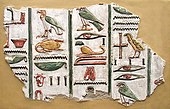 Hieroglyphs from the tomb of Seti I
Hieroglyphs from the tomb of Seti I
Furniture
| This section does not cite any sources. Please help improve this section by adding citations to reliable sources. Unsourced material may be challenged and removed. (February 2019) (Learn how and when to remove this message) |

Although, by modern standards, ancient Egyptian houses would have been very sparsely furnished, woodworking and cabinet-making were highly developed crafts. All the main types of furniture are attested, either as surviving examples or in tomb decoration. Charis were only for the wealthy; most people would have used low stools. Beds consisted of a wooden frame, with matting or leather webbing to provide support; the most elaborate beds also had a canopy, hung with netting, to provide extra privacy and protection from insects. The feet of chairs, stools and beds were often modelled to resemble bulls' hooves or, in later periods, lions' feet or ducks' heads. Wooden furniture was often coated with a layer of plaster amd painted. Royal furniture was more elaborate, making use of inlays, veneers and marquetry. Funerary objects from the tomb of Tutankhamun include tables, boxes and chests, a gilded throne, and ritualbeds shaped like elongated hippos and cattle. The burial equipment of Hetepheres included a set of travelling furniture, light and easy to dismantle. Such furniture must have been used on military campaigns and other royal journeys.
-
 The Throne of Tutankhamun; 1336–1327; wood covered with sheets of gold, silver, semi-precious and other stones, faiance, glass and bronze; height: 1 m (3 ft. 5 in.); Egyptian Museum (Cairo)
The Throne of Tutankhamun; 1336–1327; wood covered with sheets of gold, silver, semi-precious and other stones, faiance, glass and bronze; height: 1 m (3 ft. 5 in.); Egyptian Museum (Cairo)
-
 Chair of Reniseneb; 1450 BC; wood, ebony & ivory; height: 86.2 cm (3315⁄16 in.); Metropolitan Museum of Art (New York City)
Chair of Reniseneb; 1450 BC; wood, ebony & ivory; height: 86.2 cm (3315⁄16 in.); Metropolitan Museum of Art (New York City)
-
 Chair of Hatnefer; 1492–1473 BC; boxwood, cypress, ebony & linen cord; height: 53 cm (207⁄8 in.); Metropolitan Museum of Art
Chair of Hatnefer; 1492–1473 BC; boxwood, cypress, ebony & linen cord; height: 53 cm (207⁄8 in.); Metropolitan Museum of Art
-
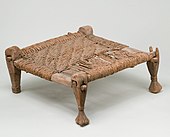 Stool with woven seat; 1991–1450; wood & reed; height: 13.3 cm (51⁄4 in.); Metropolitan Museum of Art
Stool with woven seat; 1991–1450; wood & reed; height: 13.3 cm (51⁄4 in.); Metropolitan Museum of Art
Fashion
Main article: Clothing in ancient EgyptArtistic representations, supplemented by actual surviving garments, constitute our main sources of evidences for the ancient Egyptian fashion. The two sources are not always in agreement, however, and it seems that representations were more concerned with highlighting certain attributes of the person depicted than with accurately recordings their true appearance. For example, in art created for men, women were often shown with restrictive, tight-fitting dresses, perhaps to emphasize their figures.
As in most societies, fashions in Egypt changed over time; different clothes were worn in different seasons of the year, and by different sections of society. Particular office-holders, especially priests and the king, had their own special garments.
For the general population, clothing was simple, predominantly of linen, and probably white or off-white in colour. It would have shown the dirt easily, and professional launderers are known to have been attached to the New Kingdom workmen's village at Deir el-Medina. Men would have worn a simple loin-cloth or short kilt (known as shendyt), supplemented in winter by a heavier tunic. High-status individuals could express their status through their clothing, and were more susceptible to changes in fashion.
Longer, more voluminous clothing made an appearance in the Middle Kingdom; flowing, elaborately pleated, diaphanous robes for men and women were particularly popular in the late 18th Dynasty and the Ramesside period. Decorated textiles also became more common in the New Kingdom. In all periods, women's dresses may have been enhanced by colourful bead netting worn over the top. In the Roman Period, Egypt became known for the manufacture of fine clothing. Sandals of leather or basketry are the most commonly attested types of footwear. Examples of these, together with linen shirts and other clothing, were discovered in the tomb of Tutankhamun.
-
 Pair of sandals; 1390-1352 BC; grass, reed and papyrus; Metropolitan Museum of Art (New York City)
Pair of sandals; 1390-1352 BC; grass, reed and papyrus; Metropolitan Museum of Art (New York City)
-
 Illustration from a book named Ancient Egyptian, Assyrian, and Persian costumes and decorations
Illustration from a book named Ancient Egyptian, Assyrian, and Persian costumes and decorations
-
 Illustration of a Goddess from a book named Ancient Egyptian, Assyrian, and Persian costumes and decorations
Illustration of a Goddess from a book named Ancient Egyptian, Assyrian, and Persian costumes and decorations
-
Statue of Sobekhotep VI, who wears the Egyptian male skirt, the shendyt from Neues Museum (Berlin, Germany)
Cosmetics
Use of makeup, especially around the eyes, was a characteristic feature of ancient Egyptian culture from Predynastic times. Kohl (eye-paint) was applied to protect the eyes, as well as for aesthetic reasons. It was usually made of galena, giving a silvery-black colour; during the Old Kingdom, green eye-paint was also used, made from malachite. Egyptian women painted their lips and cheeks, using rouge made from red ochre. Henna was applied as a dye for hair, fingernails and toenails, and perhaps also nipples. Creams and unguents to condition the skin were popular, and were made from various plant extracts.
-
 Cosmetic Box of the Royal Butler Kemeni; 1814–1805 BC; cedar with ebony, ivory veneer and silver mounting; height: 20.3 cm (8 in.); Metropolitan Museum of Art (New York City)
Cosmetic Box of the Royal Butler Kemeni; 1814–1805 BC; cedar with ebony, ivory veneer and silver mounting; height: 20.3 cm (8 in.); Metropolitan Museum of Art (New York City)
-
 Cosmetic dish in the shape of a tilapia fish; 1479–1425 BC; glazed steatite; height: 8.6 cm (33⁄8 in.); width: 18.1 cm (71⁄8 in.); Metropolitan Museum of Art
Cosmetic dish in the shape of a tilapia fish; 1479–1425 BC; glazed steatite; height: 8.6 cm (33⁄8 in.); width: 18.1 cm (71⁄8 in.); Metropolitan Museum of Art
-
 Cosmetic box in the shape of an Egyptian composite capital, its cap being in the left side; 664–300 BC; glassy faience; height: 8.5 cm (33⁄8 in.), width: 9 cm (39⁄16 in.); Metropolitan Museum of Art
Cosmetic box in the shape of an Egyptian composite capital, its cap being in the left side; 664–300 BC; glassy faience; height: 8.5 cm (33⁄8 in.), width: 9 cm (39⁄16 in.); Metropolitan Museum of Art
-
 Perfume vase in shape of an amphoriskos; 664–630 BC; glass: height: 8 (31⁄8 in.), diameter: 4 cm (19⁄16 in.); Metropolitan Museum of Art
Perfume vase in shape of an amphoriskos; 664–630 BC; glass: height: 8 (31⁄8 in.), diameter: 4 cm (19⁄16 in.); Metropolitan Museum of Art
Music
Main article: Music of EgyptOn secular and religious occasions, music played an important part in celebrations. Musicians, playing instruments such as the castanets and flute, are depicted on objects from the Predynastic Period. A wide range of percussions, wind and string instruments were known to the ancient Egyptian. They include rattles, clappers, drums, tabourines and the sistrum; pipes, flutes and trumpets; and harps (particularly popular at feasts). The lyre and lute were introduced from the Levant. Musical notations is not attested until the early Ptolemaic Period. Groups of musicians, either mixed gender or female only, are known from the Old Kingdom. Women singers and sistrum-players had an important role in temple cults, especially those of Hathor and Isis. Tomb decoration from all periods indicates that, as today, groups of workers sang to generate a sense of solidarity and to maintain their enthusiasm.
-
 Arched Harp (shoulder harp); 1390–1295 BC; wood; length of sound box: 36 cm; Metropolitan Museum of Art (New York City)
Arched Harp (shoulder harp); 1390–1295 BC; wood; length of sound box: 36 cm; Metropolitan Museum of Art (New York City)
-
 Head of Hathor from a clapper; 1295–664 BC; possibly boxwood; height: 12 cm, width: 6.2 cm; Metropolitan Museum of Art
Head of Hathor from a clapper; 1295–664 BC; possibly boxwood; height: 12 cm, width: 6.2 cm; Metropolitan Museum of Art
-
 Detail of a freize from TT52 in which are depicted three musicians
Detail of a freize from TT52 in which are depicted three musicians
-
 Illustration of a harper playing in front of god Shu
Illustration of a harper playing in front of god Shu
Sistrum
Main article: SistrumA sistrum (plural: sistra) is a rattle used in religious ceremonies, especially temple rituals, and usually played by women. Called a "seshsehet" in Egyptian, the name imitates the swishing sound the small metal disks made when the instrument was shaken. It was closely associated with Hathor in her role as "lady of music", and the handle was often decorated with a Hathor head. Two kinds of sistrum are attested, naos-shaped and hoop-shaped; the latter became the more common.
-
 Hathor-shaped sistrum; 664-332 BC; faience; length: 15.5 cm; Metropolitan Museum of Art (New York City)
Hathor-shaped sistrum; 664-332 BC; faience; length: 15.5 cm; Metropolitan Museum of Art (New York City)
-
 Sistrum inscribed with the name of Ptolemy I; 305-282 BC; faience; height: 26.7 cm, width: 7.5 cm; Metropolitan Museum of Art
Sistrum inscribed with the name of Ptolemy I; 305-282 BC; faience; height: 26.7 cm, width: 7.5 cm; Metropolitan Museum of Art
-
 Sistrum with the face of the goddess Hathor is depicted with cow ears on the handle of the rattle; 380-250 BC; bronze; Walters Art Museum (Baltimore, USA)
Sistrum with the face of the goddess Hathor is depicted with cow ears on the handle of the rattle; 380-250 BC; bronze; Walters Art Museum (Baltimore, USA)
-
 1st–2nd century AD; bronze or copper alloy; height: 20.6 cm, width: 14 cm; Metropolitan Museum of Art
1st–2nd century AD; bronze or copper alloy; height: 20.6 cm, width: 14 cm; Metropolitan Museum of Art
Funerary art
Coffins

The earliest purpose-built funerary containers for bodies were simple rectangular wooden boxes, attested in the 1st Dynasty. A coffin swiftly became an essential part of the burial equipment. Known euphemistically as the "lord of life", its primary function was to provide a home for the Ka and to protect the physical body from harm. In the 4th Dynasty, the development of longer coffins allowed the body to be buried fully extended (rather than curled up on its side in a foetal position). At the end of the Old Kingdom, it became customary once more for the body to be laid on its side. The side of the coffin that faced east in the tomb was decorated with a pair of eyes so that the deceased could look out towards the rising sun with its promise of daily rebirth. Coffins also began to be decorated on the outside with bands of funerary texts, while pictures of food and drink offerings were painted on the inside to provide a magical substitute for the real provisions placed in the tomb. In the 1st Intermediate Period, decorated coffins became a substitute for tomb decoration; in the Middle Kingdom, coffin texts made their first appearance, sometimes accompanied by detailed maps of the underworld. Middle Kingdom coffins show a number of distinct regional styles, echoing the cultural fragmentation of the preceding period. In the 17th and early 18th Dynasties, the Theban area produced characteristic anthropoid rishi (feathered) coffins. These were replaced (except for kings) by other styles of anthropoid coffins which became the standard form throughout the country for the remainder of Egyptian history. The predominance of decorated tombs in the New Kingdom removed the need of object friezes, so coffins were generally undecorated on the inside. However, this situation was reversed again in the 3rd Intermediate Period when new types of coffin decoration focused on the Osiris myth and extracts from the Book of the Dead, to aid the resurrection of the deceased. In the Ptolemaic and Roman periods, a cartonnage mask was often fixed directly onto the mummy wrappings as a substitute for a coffin.
Coffins were generally made of wood; those of high-status individuals used fine quality, imported cedar. From the Middle Kingdom onwards, wealthy individuals were often provided with a set of two or three nested coffins. The most sumptuous coffins might be inlaid with glass or precious stones, while royal coffins were often made from gold or silver.
-
 Coffin of the estate manager Khnumhotep; 1981–1802 BC; painted wood (ficus sycomorus); height: 81.3 cm (32 in.); Metropolitan Museum of Art (New York City)
Coffin of the estate manager Khnumhotep; 1981–1802 BC; painted wood (ficus sycomorus); height: 81.3 cm (32 in.); Metropolitan Museum of Art (New York City)
-
 Inner coffin of Khonsu; 1279–1213 BC; painted wood & gesso; height: 188 cm (74 in.); Metropolitan Museum of Art
Inner coffin of Khonsu; 1279–1213 BC; painted wood & gesso; height: 188 cm (74 in.); Metropolitan Museum of Art
-
 Inner coffin of Amenemopet; 975–909 BC; painted wood & gesso; length: 195 cm (763⁄4 in.); Metropolitan Museum of Art
Inner coffin of Amenemopet; 975–909 BC; painted wood & gesso; length: 195 cm (763⁄4 in.); Metropolitan Museum of Art
-
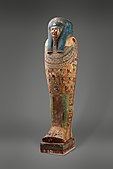 Coffin of Irtirutja; 332–250 BC; plastered, painted and gilded wood; length: 198.8 cm (781⁄4 in.); Metropolitan Museum of Art
Coffin of Irtirutja; 332–250 BC; plastered, painted and gilded wood; length: 198.8 cm (781⁄4 in.); Metropolitan Museum of Art
Canopic jars
Main article: Canopic jarVessels used for storing the internal organs removed during mummification, and named after the human-headed jars that were worshipped as personifications of Kanops (the helmsman of Menelaus in Greek mythology) by the inhabitants of ancient Canopus. The practice of evisceration is first attested in the burial of Hetepheres in the early 4th Dynasty. Her organs were stored in a travertine chest divided into four compartments. Later, each organ - the liver, lungs, stomach and intestines - was provided with a separate jar, of stone or pottery, and placed under the symbolic protection of one of the Four sons of Horus. During the 1st Intermediate Period, the stoppers of canopic jars began to be modelled in the form of human heads. From the late 18th Dynasty, they were more commonly modelled to resemble the heads of the protecting genii (baboon, jackal, falcon and human). This became the standard for canopic equipment in the 19th Dynasty. In the 3rd Intermediate Period, the mummified organs were generally returned to the body, but wealthy burials could still include a dummy set of jars. The last known royal set of canopic jars were made of Apries. The manufacture of canopic equipment continued into the Ptolemaic Period but ceased by Roman times.
-
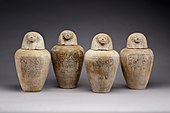 Canopic jars of Ruiu; 1504–1447 BC; painted pottery; Metropolitan Museum of Art (New York City)
Canopic jars of Ruiu; 1504–1447 BC; painted pottery; Metropolitan Museum of Art (New York City)
-
 Canopic jars of Tutankhamun; 1333–1323 BC; alabaster; total height: 85.5 cm; Egyptian Museum (Cairo)
Canopic jars of Tutankhamun; 1333–1323 BC; alabaster; total height: 85.5 cm; Egyptian Museum (Cairo)
-
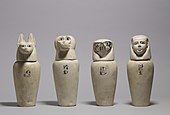 Complete set of canopic jars; 900–800 BC; painted limestone; Walters Art Museum (Baltimore, USA)
Complete set of canopic jars; 900–800 BC; painted limestone; Walters Art Museum (Baltimore, USA)
-
 Complete set of canopic jars decorated with hieroglyphics; 744–656 BC; painted sycomore fig wood; height: 28 cm; British Museum (London)
Complete set of canopic jars decorated with hieroglyphics; 744–656 BC; painted sycomore fig wood; height: 28 cm; British Museum (London)
Masks
Funerary masks have been at all periods. Famous examples range from the gold masks of Tutankhamun and Psusennes I to the Roman "mummy portraits" from Hawara and the Fayum. Whether in a funerary or religious context, the purpose of a mask was the same: to transform the wearer from a mortal to a divine state.
-
 Mask of Sitdjehuti; circa 1500 BC; imen, plaster, gold and paint; height: 61 cm (24 in.); British Museum (London)
Mask of Sitdjehuti; circa 1500 BC; imen, plaster, gold and paint; height: 61 cm (24 in.); British Museum (London)
-
 Mask of Tjuyu; 1387–1350 BC; gold, past of glass, alabaster and other materials; height: 40 cm; Egyptian Museum (Cairo)
Mask of Tjuyu; 1387–1350 BC; gold, past of glass, alabaster and other materials; height: 40 cm; Egyptian Museum (Cairo)
-
 The Mask of Tutankhamun; c. 1327 BCE; gold, glass and semi-precious stones; height: 54 cm (211⁄4 in.); Egyptian Museum
The Mask of Tutankhamun; c. 1327 BCE; gold, glass and semi-precious stones; height: 54 cm (211⁄4 in.); Egyptian Museum
-
 Portrait of a young woman in red; 90–120 AD; encaustic painting on limewood with gold leaf; height: 38.1 cm (15 in.); Metropolitan Museum of Art (New York City)
Portrait of a young woman in red; 90–120 AD; encaustic painting on limewood with gold leaf; height: 38.1 cm (15 in.); Metropolitan Museum of Art (New York City)
Ushabti
Main article: UshabtiUshabtis (also known as shawabti or shabti) are funerary figurines, the purpose of which was to act as a substitute for the deceased when he was called upon to perform agricultural work or corvée labour in the afterlife. Ushabtis evolved in the Middle Kingdom from the servant statues included among funerary gods. The earliest examples were crude statuettes in wax, clay or wood; later, they were fashioned as mummiform figures and, from the end of the 12th Dynasty, they were customarily inscribed with the "ushabti text" (chapter 6 of the Book of the dead which specifies the ushabti's duties).
-
 Shabti of Paser, the vizier of Seti I and Ramesses II; 1294–1213 BC; faience; height: 15 cm (57⁄8 in.); Metropolitan Museum of Art (New York City)
Shabti of Paser, the vizier of Seti I and Ramesses II; 1294–1213 BC; faience; height: 15 cm (57⁄8 in.); Metropolitan Museum of Art (New York City)
-
 Shabti of Sennedjem; 1279–1213 BC; painted limestone; height: 27 cm (105⁄8 in.); Metropolitan Museum of Art
Shabti of Sennedjem; 1279–1213 BC; painted limestone; height: 27 cm (105⁄8 in.); Metropolitan Museum of Art
-
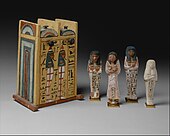 Four ushabtis of Khabekhnet and their box; 1279–1213 BC; painted limestone; height of the ushabtis: 16.7 cm (69⁄16 in.); Metropolitan Museum of Art
Four ushabtis of Khabekhnet and their box; 1279–1213 BC; painted limestone; height of the ushabtis: 16.7 cm (69⁄16 in.); Metropolitan Museum of Art
-
Ushabti; 360–343 BC; from Saqqara; Museum of Art and History (Geneva, Switzerland)
History of Egyptian art
Art of Prehistoric Egypt

The prehistory of Egypt spans the period from the earliest human settlement to the beginning of the Early Dynastic Period around 3100 BC, starting with the first Pharaoh, Narmer for some Egyptologists, Hor-Aha for others, with the name Menes also possibly used for one of these kings. This Predynastic era is traditionally equivalent to the final part of the Neolithic period beginning c. 6000 BC and ends in the Naqada III period c. 3000 BC.
Continued expansion of the desert forced the early ancestors of the Egyptians to settle around the Nile more permanently and adopt a more sedentary lifestyle during the Neolithic. The period from 9000 to 6000 BC has left very little in the way of archaeological evidence. Around 6000 BC, Neolithic settlements appear all over Egypt. Studies based on morphological, genetic, and archaeological data have attributed these settlements to migrants from the Fertile Crescent in the Near East returning during the Egyptian and North African Neolithic, bringing agriculture to the region. However, other regions in Africa independently developed agriculture at about the same time: the Ethiopian highlands, the Sahel, and West Africa.
Merimde culture (5000-4200 BC
From about 5000 to 4200 BC the Merimde culture, so far only known from a big settlement site at the edge of the Western Delta, flourished in Lower Egypt. The culture has strong connections to the Faiyum A culture as well as the Levant. People lived in small huts, produced a simple undecorated pottery and had stone tools. Cattle, sheep, goats and pigs were held. Wheat, sorghum and barley were planted. The Merimde people buried their dead within the settlement and produced clay figurines. The first Egyptian lifesize head made of clay comes from Merimde.
Badarian culture (4400-4000 BC)

The Badarian culture, from about 4400 to 4000 BC, is named for the Badari site near Der Tasa. It followed the Tasian culture, but was so similar that many consider them one continuous period. The Badarian Culture continued to produce the kind of pottery called blacktop-ware (albeit much improved in quality) and was assigned Sequence Dating numbers 21–29. The primary difference that prevents scholars from merging the two periods is that Badarian sites use copper in addition to stone and are thus chalcolithic settlements, while the Neolithic Tasian sites are still considered Stone Age.
Naqada culture (4000-3000 BC)

The Naqada culture is an archaeological culture of Chalcolithic Predynastic Egypt (ca. 4400–3000 BC), named for the town of Naqada, Qena Governorate. It is divided in three sub-periods: Naqada I, II and III.
Naqada I
The Amratian (Naqada I) culture lasted from about 4000 to 3500 BC. Black-topped ware continues to appear, but white cross-line ware, a type of pottery which has been decorated with close parallel white lines being crossed by another set of close parallel white lines, is also found at this time. The Amratian period falls between S.D. 30 and 39 in Petrie's Sequence Dating system.
Naqada II

The Gerzean culture (Naqada II), from about 3500 to 3200 BC, is named after the site of Gerzeh. It was the next stage in Egyptian cultural development, and it was during this time that the foundation of Dynastic Egypt was laid. Gerzean culture is largely an unbroken development out of Amratian Culture, starting in the delta and moving south through upper Egypt, but failing to dislodge Amratian culture in Nubia. Gerzean pottery is assigned values from S.D. 40 through 62, and is distinctly different from Amratian white cross-lined wares or black-topped ware. Gerzean pottery was painted mostly in dark red with pictures of animals, people, and ships, as well as geometric symbols that appear derived from animals. Also, "wavy" handles, rare before this period (though occasionally found as early as S.D. 35) became more common and more elaborate until they were almost completely ornamental.
Gebel el-Arak knife (3300-3200 BC)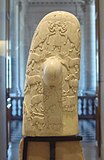

Although the Gerzean Culture is now clearly identified as being the continuation of the Amratian period, significant amounts of Mesopotamian influences worked their way into Egypt during the Gerzean, which are indicative of Egypt-Mesopotamia relations.
Distinctly foreign objects and art forms entered Egypt during this period, indicating contacts with several parts of Asia. Objects such as the Gebel el-Arak knife handle, which has patently Mesopotamian relief carvings on it, have been found in Egypt, and the silver which appears in this period can only have been obtained from Asia Minor.

In addition, Egyptian objects are created which clearly mimic Mesopotamian forms, although not slavishly. Cylinder seals appear in Egypt, as well as recessed paneling architecture, the Egyptian reliefs on cosmetic palettes are clearly made in the same style as the contemporary Mesopotamian Uruk culture, and the ceremonial mace heads which turn up from the late Gerzean and early Semainean are crafted in the Mesopotamian "pear-shaped" style, instead of the Egyptian native style.
The route of this trade is difficult to determine, but contact with Canaan does not predate the early dynastic, so it is usually assumed to have been by water. During the time when the Dynastic Race Theory was still popular, it was theorized that Uruk sailors circumnavigated Arabia, but a Mediterranean route, probably by middlemen through Byblos, is more likely, as evidenced by the presence of Byblian objects in Egypt.
The fact that so many Gerzean sites are at the mouths of wadis which lead to the Red Sea may indicate some amount of trade via the Red Sea (though Byblian trade potentially could have crossed the Sinai and then taken to the Red Sea). Also, it is considered unlikely that something as complicated as recessed panel architecture could have worked its way into Egypt by proxy, and at least a small contingent of migrants is often suspected.
Despite this evidence of foreign influence, Egyptologists generally agree that the Gerzean Culture is still predominantly indigenous to Egypt.
Protodynastic Period (Naqada III)
Main article: Naqada III
The Naqada III period, from about 3200 to 3000 BC, is generally taken to be identical with the Protodynastic period, during which Egypt was unified.
Naqada III is notable for being the first era with hieroglyphs (though this is disputed by some), the first regular use of serekhs, the first irrigation, and the first appearance of royal cemeteries. The art of the Naqada III period becomes quite sophisticated, exmaplified by the Cosmetic palettes, originally used in predynastic Egypt to grind and apply ingredients for facial or body cosmetics. The decorative palettes of the late 4th millennium BCE appear to have lost this function and became commemorative, ornamental, and possibly ceremonial. They were made almost exclusively out of siltstone with a few exceptions. The siltstone originated from quarries in the Wadi Hammamat. Many of the palettes were found at Hierakonpolis, a centre of power in pre-dynastic Upper Egypt. After the unification of the country, the palettes ceased to be included in tomb assemblages.
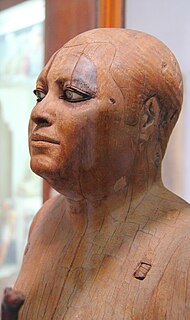
Amarna period
| This section does not cite any sources. Please help improve this section by adding citations to reliable sources. Unsourced material may be challenged and removed. (February 2019) (Learn how and when to remove this message) |
The Amarna period and the years before the pharaoh Akhenaten moved the capital there in the late Eighteenth Dynasty form the most drastic interruption to the continuity of style in the Old and New Kingdoms. Amarna art is characterized by a sense of movement and activity in images, with figures having raised heads, many figures overlapping and many scenes full and crowded. As the new religion was a monotheistic worship of the sun, sacrifices and worship were apparently conducted in open courtyards, and sunk relief decoration was widely used in these.
The human body is portrayed differently in the Amarna style than Egyptian art on the whole. For instance, many depictions of Akhenaten's body give him distinctly feminine qualities, such as large hips, prominent breasts, and a larger stomach and thighs. This is a divergence from the earlier Egyptian art which shows men with perfectly chiseled bodies. Faces are still shown exclusively in profile.
Not many buildings from this period have survived the ravages of later kings, partially as they were constructed out of standard size blocks, known as Talatat, which were very easy to remove and reuse. Temples in Amarna, following the trend, did not follow traditional Egyptian customs and were open, without ceilings, and had no closing doors. In the generation after Akhenaten's death, artists reverted to their old styles. There were still traces of this period's style in later art, but in most respects, Egyptian art, like Egyptian religion, resumed its usual characteristics after the death of Akhenaten as though the period had never happened. Amarna itself was abandoned and considerable trouble was gone to in defacing monuments from the reign, including dis-assembling buildings and reusing the blocks with their decoration facing inwards, as has recently been discovered in one later building.
-
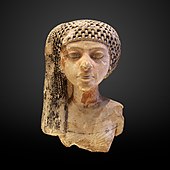 Portrait of Meritaten; 1351–1332 BC; painted limestone; height: 15.4 cm (6 in.); Louvre
Portrait of Meritaten; 1351–1332 BC; painted limestone; height: 15.4 cm (6 in.); Louvre
-
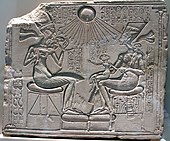 Relief of the royal family, which consists of Akhenaten, Nefertiti and three daughters; 1352–1336 BC; painted limestone; 25 x 20 cm (9 x 7 in.); Egyptian Museum of Berlin (Germany)
Relief of the royal family, which consists of Akhenaten, Nefertiti and three daughters; 1352–1336 BC; painted limestone; 25 x 20 cm (9 x 7 in.); Egyptian Museum of Berlin (Germany)
-
 The Bust of Nefertiti; 1352–1336 BC; limestone, plaster & paint; height: 48 cm (197⁄8 in.); from Amarna (Egypt); Egyptian Museum of Berlin
The Bust of Nefertiti; 1352–1336 BC; limestone, plaster & paint; height: 48 cm (197⁄8 in.); from Amarna (Egypt); Egyptian Museum of Berlin
-
 Blue-painted storage jar; 1353–1336 BC; painted pottery; height: 69 cm (273⁄16 in.); Metropolitan Museum of Art (New York City)
Blue-painted storage jar; 1353–1336 BC; painted pottery; height: 69 cm (273⁄16 in.); Metropolitan Museum of Art (New York City)
The Late Period
In 525 BC, the political state of Egypt was taken over by the Persians, almost a century and a half into Egypt's Late Period. By 404 BC, the Persians were expelled from Egypt starting a short period of independence. These 60 years of Egyptian rule consisted of an abundance of usurpers and short reigns. Again the Egyptians were plagued with Persians as they conquered Egypt again until 332 BC with the arrival of Alexander the Great. Sources state that the Egyptians were cheering when Alexander entered the capital since he drove out the immensely disliked Persians. The Late Period is marked with the death of Alexander the Great and the start of the Ptolemaic dynasty. Although this period marks political turbulence an immense change for Egypt, its art and culture continued to flourish.
Starting with the Thirtieth Dynasty, the Fifth Dynasty in the Late Period, and extending into the Ptolemaic era. These temples ranged from the Delta to the island of Philae. While Egypt was outside fluencies through trade and conquered by foreign states, these temples were still in the traditional Egyptian style with very little Hellenistic influence.
Another relief originating from the Thirtieth Dynasty was the rounded modeling of the body and limbs. This rounded modeling refers to giving the subjects the sculpture or painting a more fleshy or heavy effect. For example, for women, their breast would swell and overlap the upper arm in painting. In more realistic portrayals, men would be fat or have wrinkled.
Another piece of art that increasingly common during was Horus stela. Horus stela originates from the late New Kingdom and intermediate period but was increasingly common during the fourth century to the Ptolemaic era. These statues would often depict a young Horus holding snakes and standing on some kind of dangerous beast. The depiction of Horus comes from the Egyptian myth where a young Horus is saved from a scorpion bite resulting in him gaining power over all dangerous animals. These statues were used "to ward off attacks from harmful creatures, and to cure snake bites and scorpion stings."
-
 Wedjad-shaped amulet; 525–332 BC; green faience; height: 5.1 cm (2 in.), width: 6.4 cm (21⁄2 in.); Metropolitan Museum of Art (New York City)
Wedjad-shaped amulet; 525–332 BC; green faience; height: 5.1 cm (2 in.), width: 6.4 cm (21⁄2 in.); Metropolitan Museum of Art (New York City)
-
 Ushabti of Nectanebo II; circa 360 BC; pale turquoise faience; overall: 19 x 6.1 x 3.8 cm (71⁄1/2 x 23⁄8 x 11⁄2 in.); Cleveland Museum of Art (Cleveland, Ohio, USA)
Ushabti of Nectanebo II; circa 360 BC; pale turquoise faience; overall: 19 x 6.1 x 3.8 cm (71⁄1/2 x 23⁄8 x 11⁄2 in.); Cleveland Museum of Art (Cleveland, Ohio, USA)
-
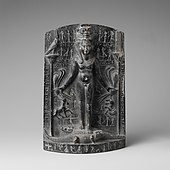 Magical stela or cippus of Horus; 332–280 BC; chlorite schist; height: 20.5 cm (81⁄16 in.); Metropolitan Museum of Art
Magical stela or cippus of Horus; 332–280 BC; chlorite schist; height: 20.5 cm (81⁄16 in.); Metropolitan Museum of Art
-
 Nectanebo I temple on Philae
Nectanebo I temple on Philae
Ptolemaic period
Discoveries made since the end of the 19th century surrounding the (now submerged) ancient Egyptian city of Heracleum at Alexandria include a 4th-century BC, unusually sensual, detailed and feministic (as opposed to deified) depiction of Isis, marking a combination of Egyptian and Hellenistic forms beginning around the time of Egypt's conquest by Alexander the Great in 332-331 BC. However this was untypical of Ptolemaic sculpture, which generally avoided mixing Egyptian styles with the general Hellenistic style which was used in the court art of the Ptolemaic dynasty, while temples in the rest of the country continued using late versions of traditional Egyptian formulae. Scholars have proposed an "Alexandrian style" in Hellenistic sculpture, but there is in fact little to connect it with Alexandria.
Marble was extensively used in court art, although it all had to be imported, and use was made of various marble-saving techniques, such as making even heads up from a number of pieces, and using stucco for beards, the back of heads and hair. In contrast to the art of other Hellenistic kingdoms, Ptolemaic royal portraits are generalized and idealized, with little concern for achieving an individual portrait, though thanks to coins some portrait sculpture can be identified as one of the 15 King Ptolemys. Many later portraits have clearly had the face reworked to show a later king. One Egyptian trait was to give much greater prominence to the queens than other successor dynasties to Alexander, with the royal couple, often shown as a pair. This predated the 2nd century, a series of queens did indeed exercise real power.
In the 2nd century, Egyptian temple sculptures did begin to reuse court models in their faces, and sculptures of a priest often used a Hellenistic style to achieve individually distinctive portrait heads. Many small statuettes were produced, with Alexander, as the founder of the dynasty, a generalized "King Ptolemy", and a naked Aphrodite among the most common types. Pottery figurines included grotesques and fashionable ladies of the Tanagra figurine style. Erotic groups featured absurdly large phalluses. Some fittings for wooden interiors include very delicately patterned polychrome falcons in faience.
-
 Box decorated with a rhinoceros beetle; 664–30 BC; cupreous metal; height: 6.4 cm (21⁄2 in.), width: 5.9 cm (25⁄16 in.); Metropolitan Museum of Art (New York City
Box decorated with a rhinoceros beetle; 664–30 BC; cupreous metal; height: 6.4 cm (21⁄2 in.), width: 5.9 cm (25⁄16 in.); Metropolitan Museum of Art (New York City
-
 Statue of the goddess Raet-Tawy; 332–30 BC; limestone; height: 46 cm, width: 13.7 cm, length: 23.7 cm; Louvre
Statue of the goddess Raet-Tawy; 332–30 BC; limestone; height: 46 cm, width: 13.7 cm, length: 23.7 cm; Louvre
-
 Ibis coffin; 305-30 BC; wood, silver, gold, and rock crystal; 38.2 x 20.2 x 55.8 cm; Brooklyn Museum
Ibis coffin; 305-30 BC; wood, silver, gold, and rock crystal; 38.2 x 20.2 x 55.8 cm; Brooklyn Museum
-
Zodiac ceiling; circa 100 BC; sandstone; length: 2.5 m (81⁄4 ft.), width: 2.5 m (81⁄4 ft.); from Dendera; Louvre
Art of Meroë
See also: MeroëAncient Egypt shared a long and complex history with the Nile Valley to the south, the region called Nubia (modern Sudan). Beginning with the Kerma culture and continuing with the Kingdom of Kush based at Napata and then Meroë, Nubian culture absorbed Egyptian influences at various times, for both political and religious reasons. The result is a rich and complex visual culture.
The artistic production of Meroë reflects a range of influences. First, it was an indigenous African culture with roots stretching back thousands of years. To this is added the fact that the wealth of Meroë was based on trade with Egypt when it was ruled by the Ptolemaic dynasty (332-330 BC) and the Romans (30 BC-395 AD), so Hellenistic and Roman objects and ideas were imported, as well as Egyptian influences.
-
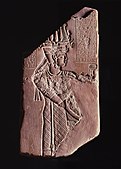 Votive plaque of king Tanyidamani; circa 100 BC; siltstone; 18.5 × 9.5 (71⁄4 × 33⁄4 in.); Walters Art Museum (Baltimore, USA)
Votive plaque of king Tanyidamani; circa 100 BC; siltstone; 18.5 × 9.5 (71⁄4 × 33⁄4 in.); Walters Art Museum (Baltimore, USA)
-
 Votive plaque of king Tanyidamani; circa 100 BC; siltstone; 18.5 × 9.5 (71⁄4 × 33⁄4 in.); Walters Art Museum
Votive plaque of king Tanyidamani; circa 100 BC; siltstone; 18.5 × 9.5 (71⁄4 × 33⁄4 in.); Walters Art Museum
-
 Pot from Faras; 300 BC – 350 AD; terracotta; height: 18 cm (7 in.); Egyptian Museum of Berlin (Germany)
Pot from Faras; 300 BC – 350 AD; terracotta; height: 18 cm (7 in.); Egyptian Museum of Berlin (Germany)
-
 Beaker; 300 BC – 350 AD; terracotta; height: 10.5 cm (41⁄4 in.); Egyptian Museum of Berlin
Beaker; 300 BC – 350 AD; terracotta; height: 10.5 cm (41⁄4 in.); Egyptian Museum of Berlin
References
- Smith, Stevenson, and Simpson, 33
- Smith, Stevenson, and Simpson, 12–13 and note 17
- Smith, Stevenson, and Simpson, 21–24
- Smith, Stevenson, and Simpson, 170–178; 192–194
- Smith, Stevenson, and Simpson, 102–103; 133–134
- The Art of Ancient Egipt. A resource for educators (PDF). New York: The Metropolitan Museum of Art. p. 44. Retrieved July 7, 2013.
- ^ Historical Atlas of Ancient Egypt, Bill Manley (1996) p. 83
- "Color in Ancient Egypt". Ancient History Encyclopedia. Retrieved 2018-10-04.
- ^ Lacovara, Peter; Markowitz, Yvonne J. (2001). "Materials and Techniques in Egyptian Art". The Collector's Eye: Masterpieces of Egyptian Art from the Thalassic Collection, Ltd. Atlanta: Michael C. Carlos Museum. pp. XXIII–XXVIII.
- Grove
- "Egyptian Book of the Dead". Ancient History Encyclopedia. Retrieved 2019-04-23.
- Smith, Stevenson, and Simpson, 2
- Smith, Stevenson, and Simpson, 4–5; 208–209
- Smith, Stevenson, and Simpson, 89–90
- ^ Gay., Robins, (1997). The art of ancient Egypt. Cambridge, Mass.: Harvard University Press. ISBN 0674046609. OCLC 36817299.
{{cite book}}: CS1 maint: extra punctuation (link) CS1 maint: multiple names: authors list (link) - Sweeney, Deborah (2004). "Forever Young? The Representation of Older and Ageing Women in Ancient Egyptian Art". Journal of the American Research Center in Egypt. 41: 67–84. doi:10.2307/20297188. JSTOR 20297188.
- Jenner, Jan (2008). Ancient Civilizations. Toronto: Scholastic.
- Redford, Donald B (1992). Egypt, Canaan, and Israel in Ancient Times. Princeton: University Press. p. 6.
- Brace, C. Loring; Seguchi, Noriko; Quintyn, Conrad B.; Fox, Sherry C.; Nelson, A. Russell; Manolis, Sotiris K.; Qifeng, Pan (2006). "The questionable contribution of the Neolithic and the Bronze Age to European craniofacial form". Proceedings of the National Academy of Sciences of the United States of America. 103 (1): 242–247. Bibcode:2006PNAS..103..242B. doi:10.1073/pnas.0509801102. PMC 1325007. PMID 16371462.
- Chicki, L; Nichols, RA; Barbujani, G; Beaumont, MA (2002). "Y genetic data support the Neolithic demic diffusion model". Proc. Natl. Acad. Sci. USA. 99 (17): 11008–11013. Bibcode:2002PNAS...9911008C. doi:10.1073/pnas.162158799. PMC 123201. PMID 12167671.
- "Estimating the Impact of Prehistoric Admixture on the Genome of Europeans, Dupanloup et al., 2004". Mbe.oxfordjournals.org. Retrieved 1 May 2012.
- Semino, O; Magri, C; Benuzzi, G; et al. (May 2004). "Origin, Diffusion, and Differentiation of Y-Chromosome Haplogroups E and J: Inferences on the Neolithization of Europe and Later Migratory Events in the Mediterranean Area, 2004". Am. J. Hum. Genet. 74: 1023–34. doi:10.1086/386295. PMC 1181965. PMID 15069642.
- Cavalli-Sforza (1997). "Paleolithic and Neolithic lineages in the European mitochondrial gene pool". Am J Hum Genet. 61: 247–54. doi:10.1016/S0002-9297(07)64303-1. PMC 1715849. PMID 9246011. Retrieved 1 May 2012.
- Chikhi (21 July 1998). "Clines of nuclear DNA markers suggest a largely Neolithic ancestry of the European gene". PNAS. 95 (15): 9053–9058. Bibcode:1998PNAS...95.9053C. doi:10.1073/pnas.95.15.9053. PMC 21201. PMID 9671803. Retrieved 1 May 2012.
- Cite error: The named reference
Bar Yosef pages 159was invoked but never defined (see the help page). - Zvelebil, M. (1986). Hunters in Transition: Mesolithic Societies and the Transition to Farming. Cambridge, UK: Cambridge University Press. pp. 5–15, 167–188.
- Bellwood, P. (2005). First Farmers: The Origins of Agricultural Societies. Malden, MA: Blackwell.
- Dokládal, M.; Brožek, J. (1961). "Physical Anthropology in Czechoslovakia: Recent Developments". Current Anthropology. 2 (5): 455–477. doi:10.1086/200228.
- Zvelebil, M. (1989). "On the transition to farming in Europe, or what was spreading with the Neolithic: a reply to Ammerman (1989)". Antiquity. 63 (239): 379–383. doi:10.1017/S0003598X00076110.
- Diamond, Jared (1999). Guns, Germs, and Steel. New York: Norton Press. ISBN 0-393-31755-2.
- Eiwanger, Josef (1999). "Merimde Beni-salame". In Bard, Kathryn A. (ed.). Encyclopedia of the Archaeology of Ancient Egypt. London/New York. pp. 501–505.
{{cite book}}: CS1 maint: location missing publisher (link) - "picture of the Merimde head" (in German). Auswaertiges-amt.de. Archived from the original on 2 March 2012. Retrieved 1 May 2012.
{{cite web}}: Unknown parameter|deadurl=ignored (|url-status=suggested) (help) - ^ Shaw, Ian, ed. (2000). The Oxford History of Ancient Egypt. Oxford University Press. p. 479. ISBN 0-19-815034-2.
- ^ Cite error: The named reference
Gardiner 389was invoked but never defined (see the help page). - ^ Gardiner, Alan, Egypt of the Pharaohs (Oxford: University Press, 1964), p. 390.
- ^ Redford, Donald B. Egypt, Canaan, and Israel in Ancient Times. (Princeton: University Press, 1992), p. 16.
- "Site officiel du musée du Louvre". cartelfr.louvre.fr.
- "Site officiel du musée du Louvre". cartelfr.louvre.fr.
- Cooper, Jerrol S. (1996). The Study of the Ancient Near East in the Twenty-first Century: The William Foxwell Albright Centennial Conference. Eisenbrauns. pp. 10–14. ISBN 9780931464966.
- Shaw, Ian. & Nicholson, Paul, The Dictionary of Ancient Egypt, (London: British Museum Press, 1995), p. 109.
- Redford, Donald B. Egypt, Canaan, and Israel in Ancient Times. (Princeton: University Press, 1992), p. 18.
- Cite error: The named reference
Redford 17was invoked but never defined (see the help page). - ^ Redford, Donald B. Egypt, Canaan, and Israel in Ancient Times. (Princeton: University Press, 1992), p. 22.
- Redford, Donald B. Egypt, Canaan, and Israel in Ancient Times. (Princeton: University Press, 1992), p. 20.
- "Naqada III". Faiyum.com. Retrieved 1 May 2012.
- Smith, 206, 208-209
- ^ Smith, 210
- Smith, 205
- Smith, 206
- Smith, 207
- Smith, 209
- Smith, 208
- Smith, 208-209, 210
Sources
- Smith, R.R.R., Hellenistic Sculpture, a handbook, Thames & Hudson, 1991, ISBN 0500202494
- Smith, W. Stevenson, and Simpson, William Kelly. The Art and Architecture of Ancient Egypt, 3rd ed. 1998, Yale University Press (Penguin/Yale History of Art), ISBN 0300077475
Further reading
Hill, Marsha (2007). Gifts for the gods: images from Egyptian temples. New York: The Metropolitan Museum of Art. ISBN 9781588392312.
External links
- Ancient Egyptian Art – Aldokkan
- Senusret Collection: A well-annotated introduction to the arts of Egypt
